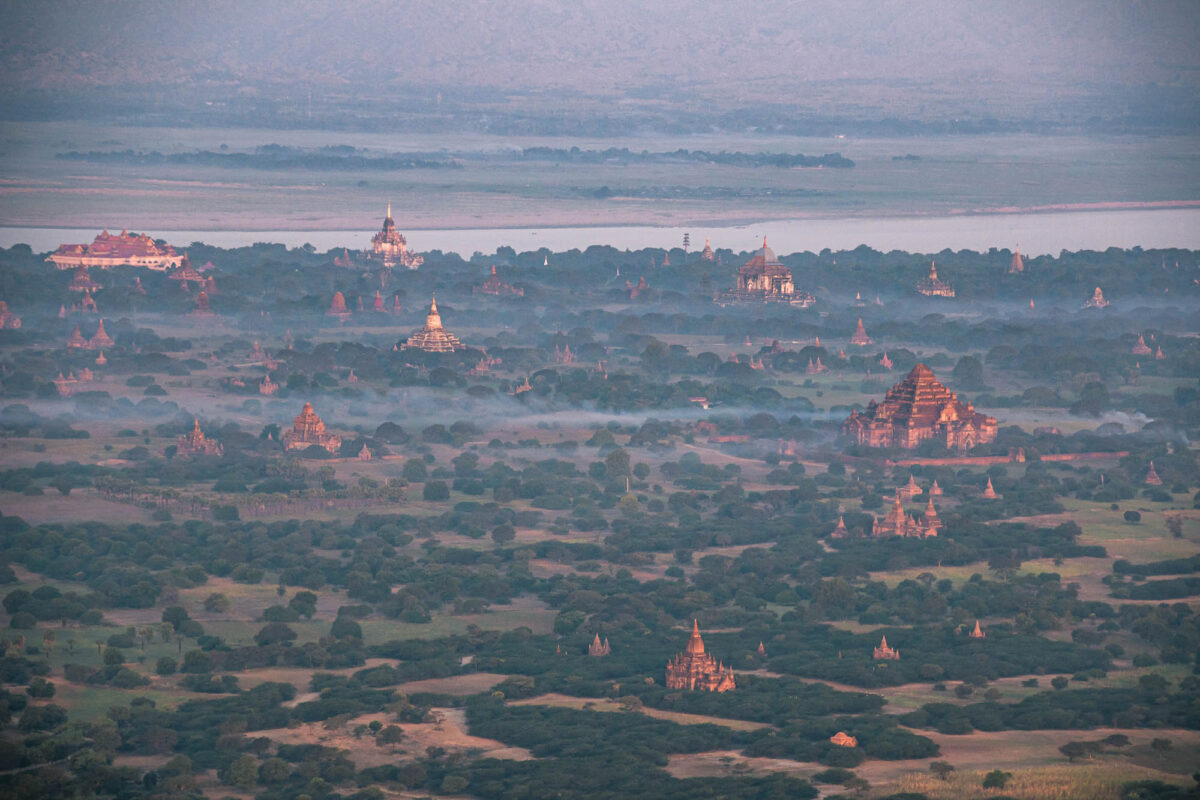ITINERARY
Our trip to Myanmar was very short so we wanted to cover the main highlights without feeling rushed. We organized our itinerary based on the local activities, transportation between the cities and our flights in and out of Myanmar. So here we go!
DAY 1: MANDALAY / AMARAPURA
Arrive in Mandalay. Spend the evening on a relaxing boat ride at U Bein bridge or hike up Mandalay hill to see the panoramic views of the city.
DAY 2: MINGUN & BAGAN
Visit Mingun in the morning to see two beautiful temples (Mingun Pahtodawgyi & Hsinbyume Pagoda). Drive to Bagan in the afternoon, and spend the evening exploring the temples or relaxing at the hotel.
DAY 3: BAGAN
Wake up early for the popular hot air balloon flights. Spend the rest of the day exploring the temple complex on an e-scooter. Enjoy the evening with a spectacular sunset over the temples.
DAY 4: BAGAN & INLE LAKE
Catch the sunrise over Bagan from a different angle, watching the balloons sail by the temples. Fly to Inle Lake in the afternoon and spend the evening relaxing on the lakeside hotel sundeck.
DAY 5: INLE LAKE
Book a full day boat tour of Inle lake and experience life on the lake, visiting several temples, local markets and cottage industries, all connected via canals.
DAY 6: YANGON
Visit the famous Shwedagon Pagoda and other attractions in the city (Kandawgyi lake, Sule Pagoda, Bogyoke Aung San Market). Take advantage of the city’s amazing bars, restaurants and street food.
Amarapura was the former capital of Myanmar, before the capital shifted to Mandalay. While the palaces of Amarapura were dismantled, today it is made popular by U Bein bridge, which is believed to be the oldest and once the longest teakwood bridge in the world.
DAY 1: AMARAPURA / MANDALAY
After multiple layovers, we landed in Mandalay right around 4 PM which left us with only a few hours of daylight. To save time, we pre-arranged an airport pick up with our hotel so we could go directly to U Bein bridge in time for sunset.
After 45 mins drive we arrived at U Bein bridge and it was nothing like we had imagined. We expected a quiet idyllic country bridge, but instead the area was swarming with people, both locals and tourists alike. The bank of the lake was dotted with colorful boats. Our driver helped us arrange a 2 hour boat ride and then we were off.
Out on the water we began to truly appreciate the length of the bridge, and the impressive wooden stilts construction. One side of the bridge has a colorful market and village fair with throngs of people enjoying an evening stroll, while the other side is much quieter, with only a few people making the journey across the bridge. Our boat tour took us into the middle of the lake, under the bridge, and back allowing us to take in the scenery and life on the lake. As sunset approached, all of the tourist boats lined up to admire the rays of the setting sun, between the wooden stilts of the bridge. The lake turned a shimmering color of gold as the local fishermen waded in the water to find their last catch of the day.
Back on land, we walked the bridge ourselves to admire the simplicity and the strength of the bridge and take in the lake from above. As night fell, we made our way to the hotel and finished our first day with a delicious dinner on the hotel rooftop.
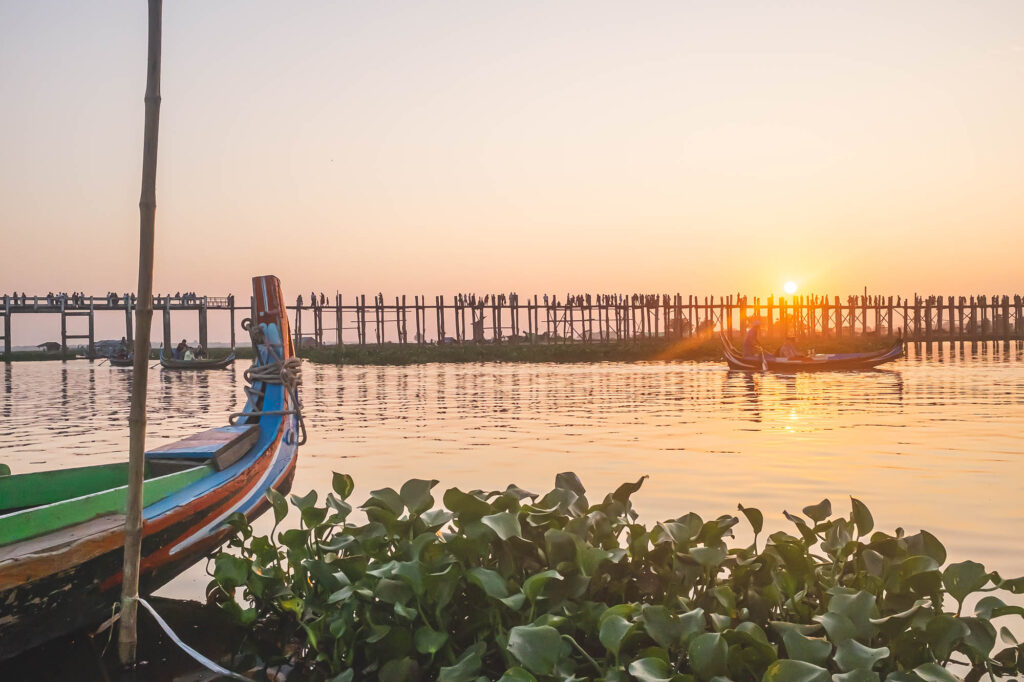
Mingun is a small town located 11 km up the Irrawaddy River on the west bank from Mandalay. Once a temporary residence for the king, it is now known for Mingun Pahtodawgyi, which would’ve been the biggest stupa in the world.
DAY 2: MINGUN
Our time in Mandalay was short and had we had more time we would have explored the city, the palace and the temples on Mandalay Hill. This time around we’d only have time to explore the temples in Mingun.
We woke up early in the hopes of catching the morning light at the temples, but we had grossly underestimated the time it takes to get there. There are two ways to reach Mingun. The simplest and perhaps the most scenic way is to sail across the Irrawaddy river from Mandalay, but since the boats didn’t leave until 9AM, we opted to drive, which took us an hour and 30 mins.
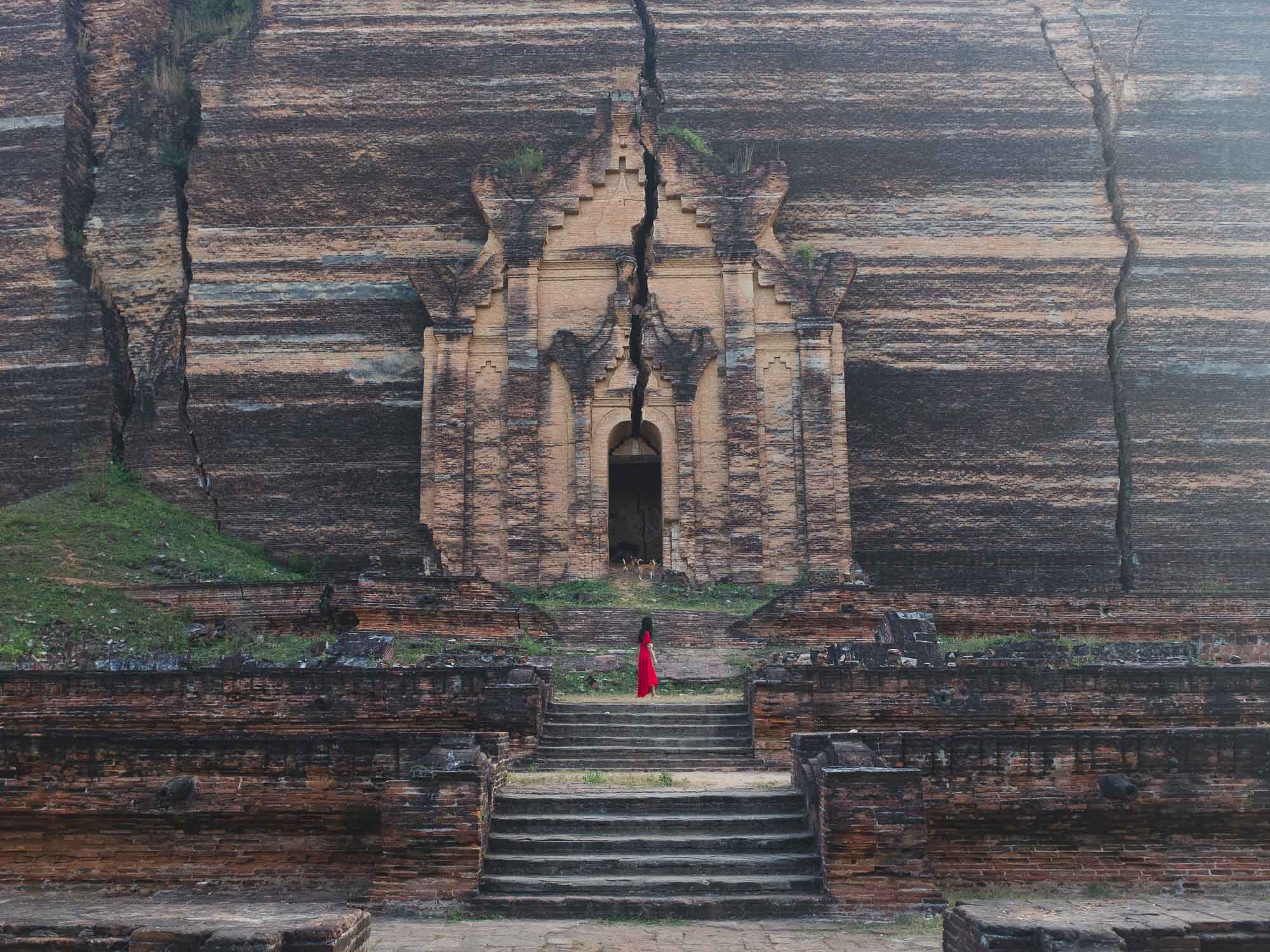
Our first stop was Mingun Pahtodawgyi, an unfinished temple in the heart of Mingun that dominates the landscape with its sheer size and volume. This temple is a solid structure made out of bricks, and some say it holds the record for being the biggest pile of bricks in the world. It is believed that King Bodawpaya abandoned the project over superstitions that the completion of the temple would bring ruin to the country or death to the king himself. Now more than 200 years later, the temple has developed huge cracks on its facade which adds to its appeal. We first saw this temple featured in one of Steve McCurry’s photos and instantly decided to add it to our itinerary. We were not disappointed. Despite being incomplete, one side of the structure has a small shrine with a buddha statue that continues to act as a place of worship.
Right across the street were two giant statues of lions meant to guard the temples. Not much of it remains since the earthquake, but the remaining structure which looks more like an elephant gives an idea of how big these statues would have been.
Our next stop was the Mingun Bell. The bell was supposed to be a part of the temple and was once the heaviest bell in the world at ~100 tons (55,555 viss, a burmese measurement system). Today the bell is walking distance from Mingun Pahtodawgyi and is worth stopping by to ring with the help of small wooden logs.
From the Bell we walked over to Mya Thein Tan Pagoda (Hsinbyume Pagoda). The temple has an elegant design and is said to be modelled after the mythical sacred mountain, Mount Meru. Perhaps the most iconic part of the temple are the seven wavy terraces below the pagoda which represent the seven mountain ranges leading up to Mount Meru. The whitewashed walls along with the wavy terraces are beautiful to photograph and are definitely worth the trip. We got here early but not early enough to beat heat. By 9 AM, the sun was already high in the sky and with the open terraces there was little shade to hide from the sun’s strong rays . Doing it again, I would try to get here even earlier or later in the evening to avoid the heat and also the harsh shadows on the temple that made photography difficult.
Wrapping up our last stop in Mingun, we got back in the car and headed to Bagan.
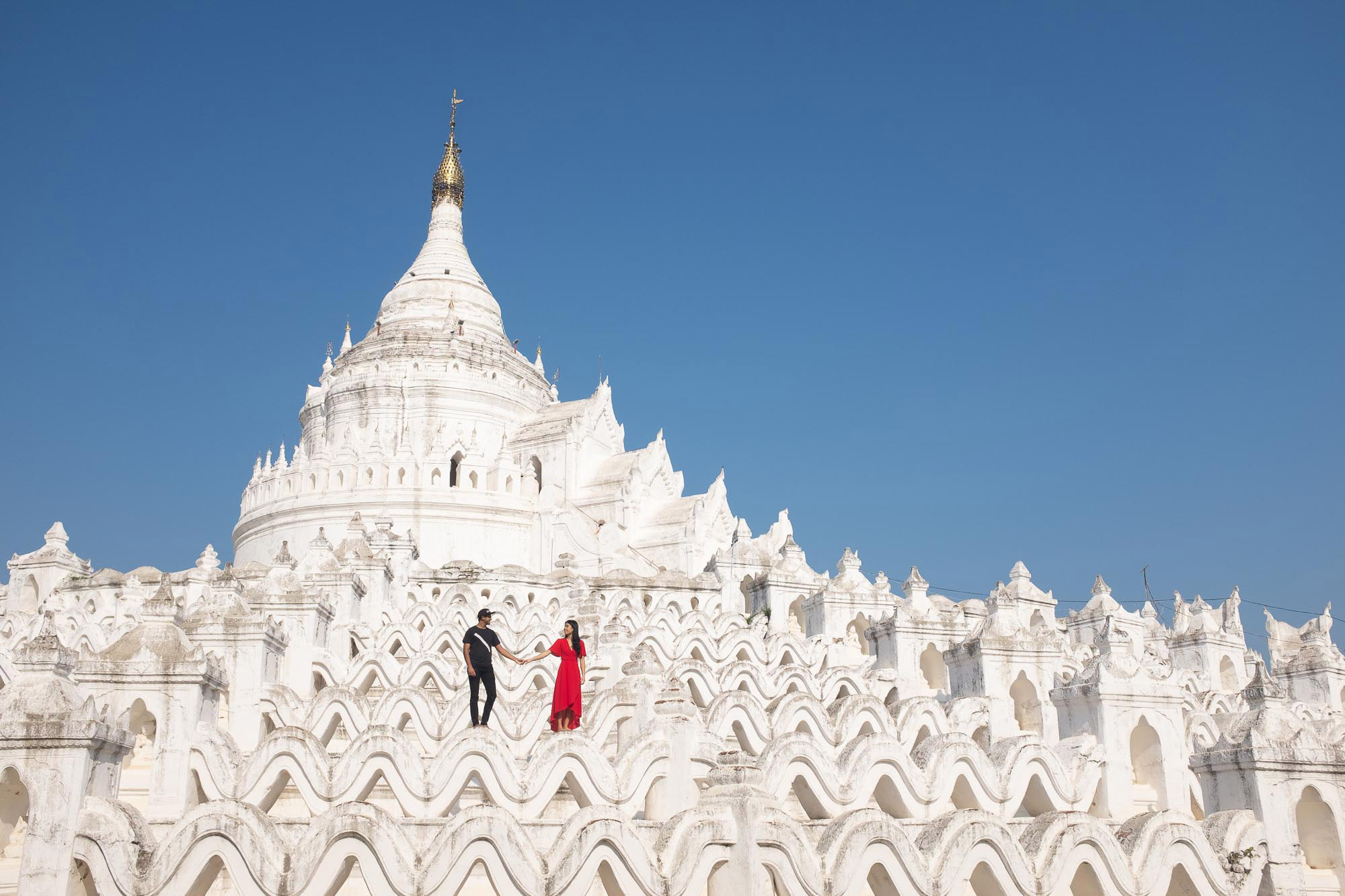
Bagan is a UNESCO world heritage site and was the capital of the unified Pagan Kingdom, precursor to modern day Myanmar. Over the years more than 10,000 temples were constructed in this region, thousands of which still survive today.
DAY 2: BAGAN
Bagan is perhaps the first place that comes to mind when traveling in Burma and it was indeed the focus of our itinerary. Only a few places in the world come close in comparison to the sprawling temple complexes of Bagan.
After roughly 4 hrs of drive from Mingun, it was mid-afternoon by the time we arrived at our hotel, the Hotel @ Tharabar Gate in Old Bagan. We picked the hotel because it’s right in the heart of the Archaeological zone and 5 mins walk from the famous Ananda Temple. After a quick check-in and some refreshments we headed out to find a place for the sunset.
The Bagan Archaeological Zone is huge (40 sq miles, roughly the size of San Francisco) and dotted with thousands of temples and pagodas, built over several centuries. We thought this area would be walled in with a clear entrance and ticket office. In reality, it’s more like a small town with hotels, restaurants and makeshift markets, in and around the temple complex. We didn’t have a proper map, so we relied heavily on our prior research, offline Google Maps and flyers from the hotel lobby. While you don’t need a map, having one is advisable as Google Maps doesn’t mark all the roads and dirt tracks between the temples (which in itself was fun when we started exploring).
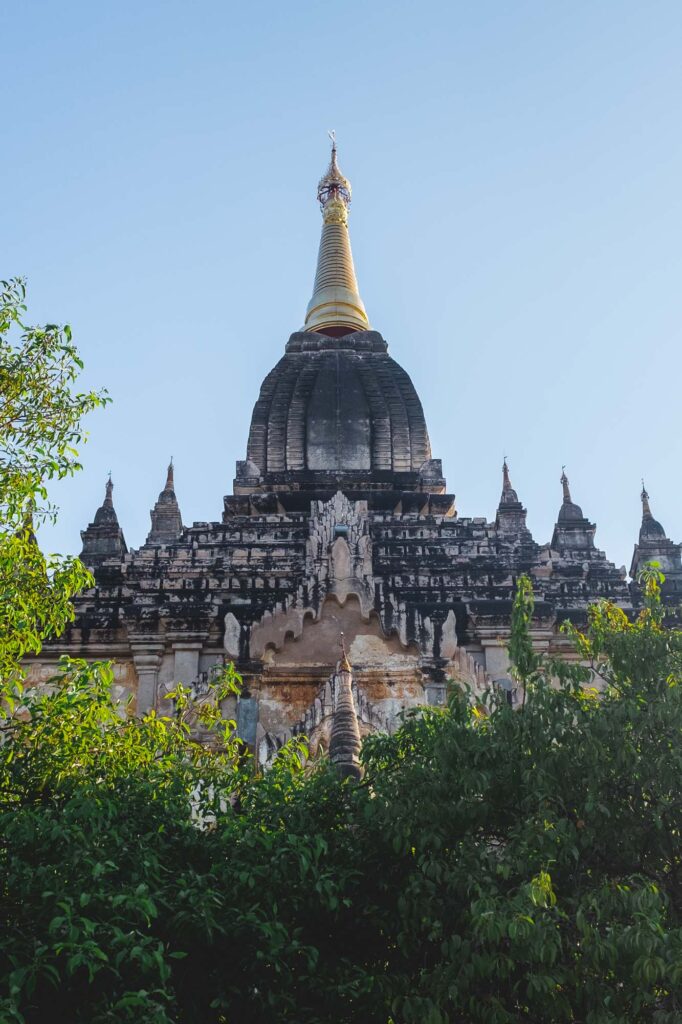
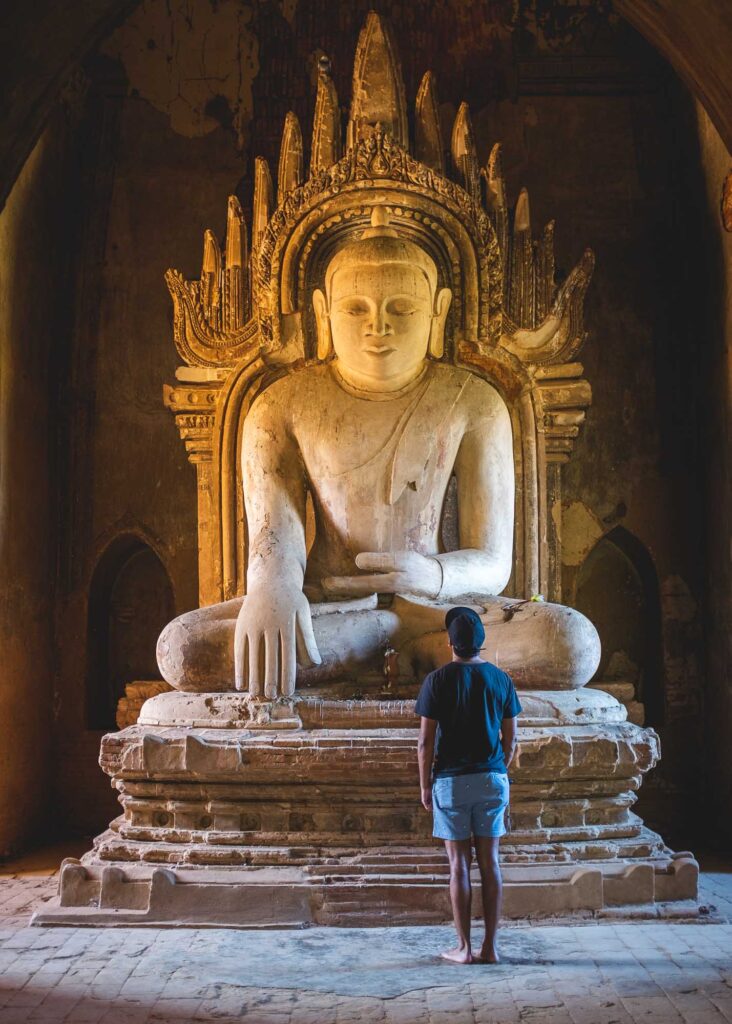
We rented an electric scooter from right outside the hotel and rode to Ananda Temple to buy entrance tickets for the archaeological zone. While there is no official entrance where the ticket is checked, it’s advisable to buy these tickets for the entire stay and to keep them with you at all times. A security guard checked our tickets once while we were at a temple, waiting for the sunrise. Our guess is that the guards know where most people congregate and at what times, so instead of checking at a designated entrance, they do it randomly at these congregation spots.
While researching Bagan, we had marked several popular temples that would’ve been ideal for watching sunset (eg Shwesandaw Pagoda, Pyathadar Hpaya), but in recent years climbing the temples has been banned to help preserve the ancient structures. . As we looked for high ground to watch the sunset, we were joined by a woman on a bike who asked us if we would be interested in seeing the temples that were still okay to climb. We were skeptical at first, but since we didn’t know where we were going ourselves we decided to follow her and she showed us three smaller temples in different parts of the complex and in exchange she wanted us to buy some handicrafts, which we did.
The temples she showed us weren’t very tall and also had been reinforced with cement. One could clearly see the cement flooring in most places instead of the bricks. They were a bit tricky to find even the roads we used to get there weren’t clearly marked on the map. After marking her recommendations, we returned to the first temple for sunset, and by then the temple was packed with tourists, sitting shoulder to shoulder at different levels of the stupa. While the temple was no more than 30ft high, it was high enough to see small temples in every direction, and to watch the last of the sun’s rays give them all a beautiful reddish glow.
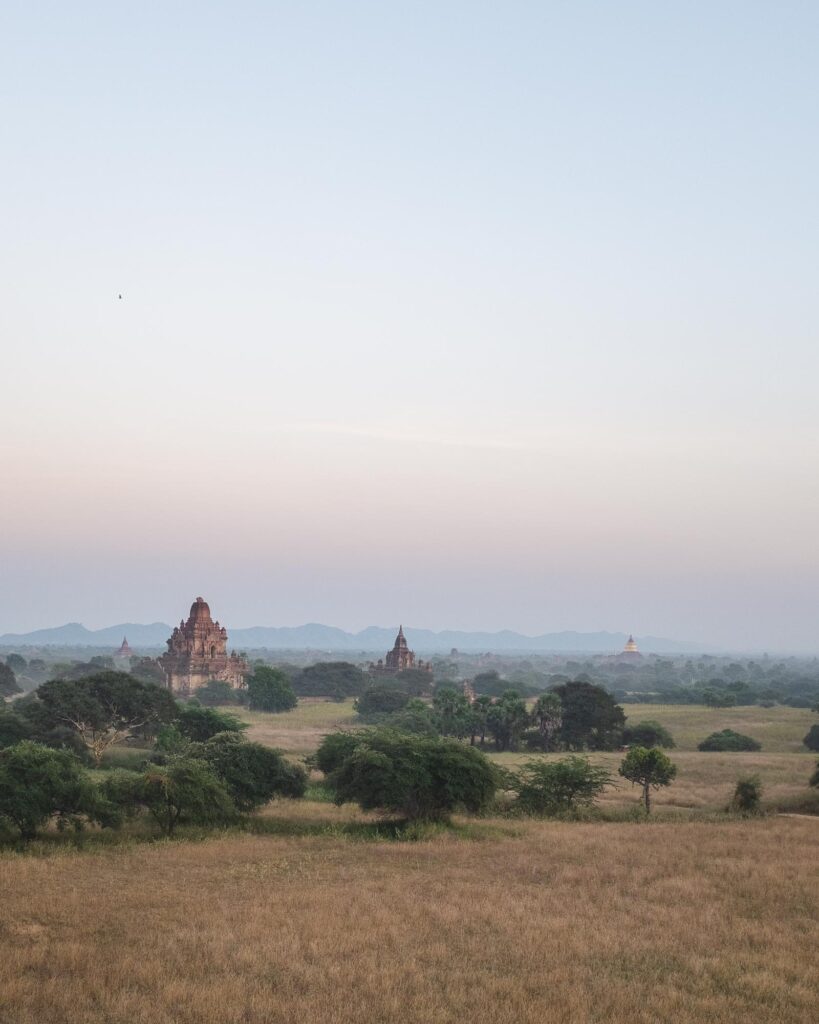
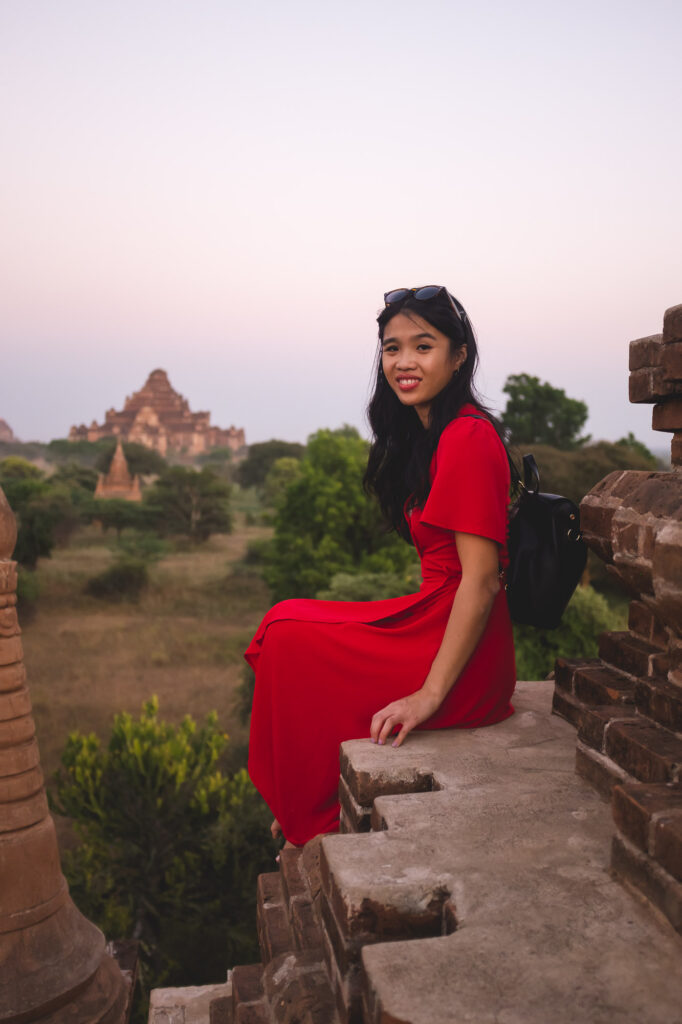
DAY 3: BAGAN
Next day, we woke up early at 5:00 AM to join several other hotel guests in the lobby. It was the day for hot air balloons over Bagan. This was probably the most expensive thing we did on our trip ($400 pp in 2018 😮) and we are glad we did. The balloons are operated by British pilots and employ a lot of staff for the whole operation. We booked our experience through Oriental Ballooning, one of the three companies that operate in Bagan (others being Balloons over Bagan & Golden Eagle). All of them take off from the same spot and have similar services, it all depends on price and availability. Definitely book ahead of time.
We drank some tea as the staff started to blow hot air into the balloons. Right before sunrise, we got into our balloon basket and soon we were off to the sky. As we rose up, we saw several balloons twirling in front of us, while more getting off the ground. In the distance we could see hundreds of stupas peeking above the fog and right behind them was the Irrawaddy river.
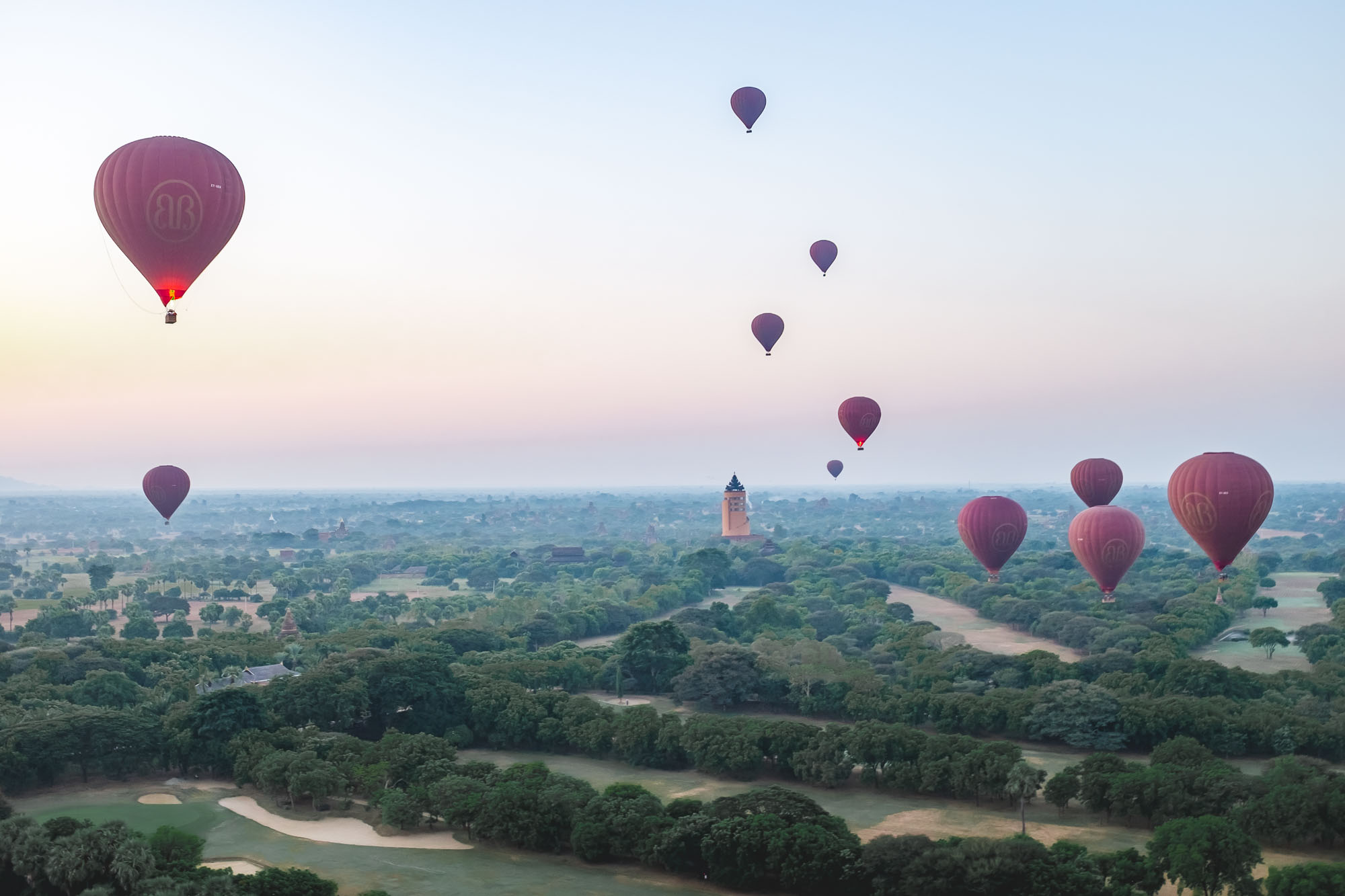
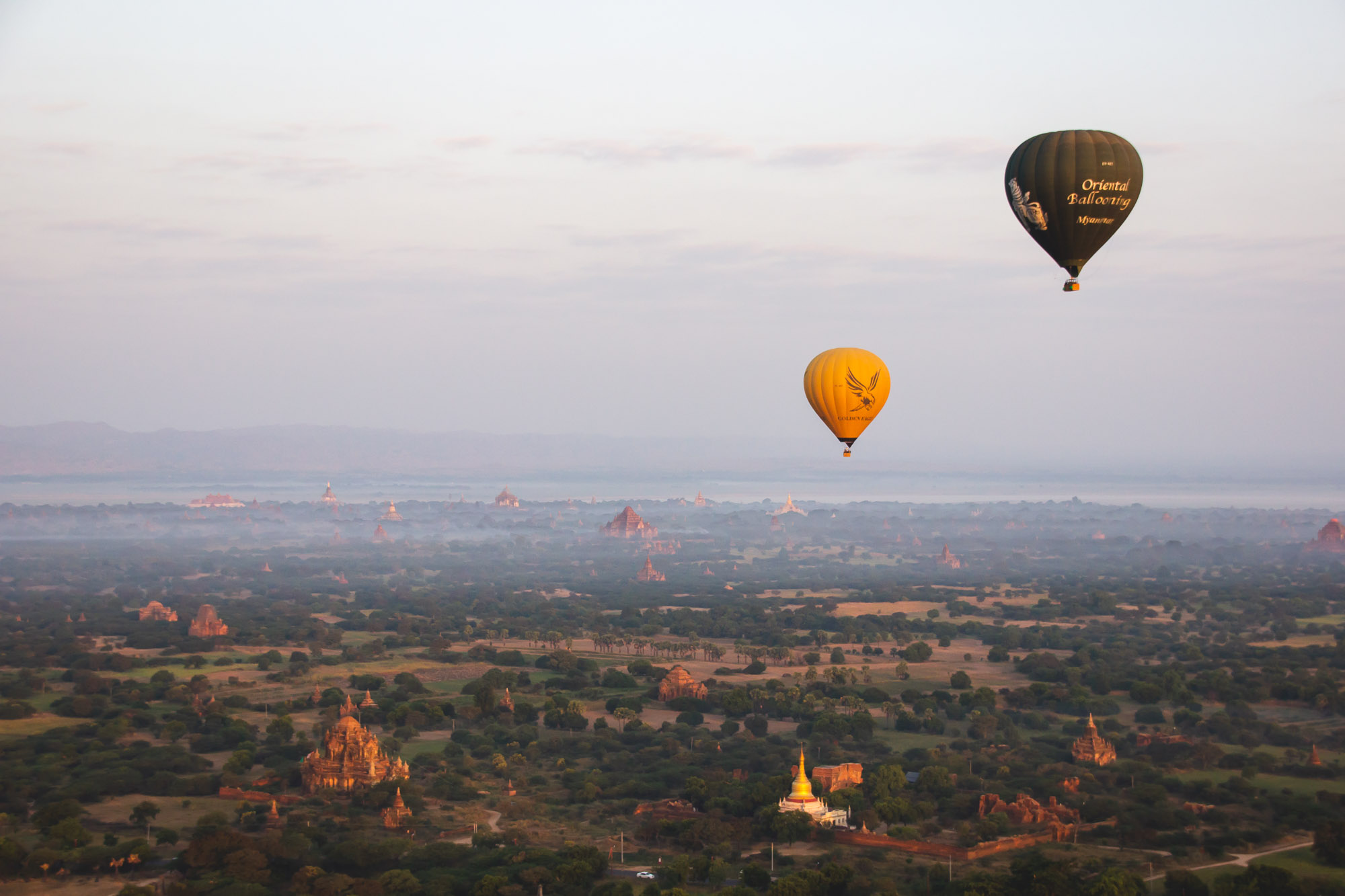
We slowly sailed above the temples and farmlands taking in the iconic views of Bagan. It was perhaps the most leisurely way to view the landscape from above. After an hour drifting in the sky we landed in a farm field where we were greeted with a champagne toast. Way to go overboard.
After we were dropped off at the hotel, we ate breakfast and snuck in a quick nap since we had gotten up so early. An hour or so later, we were ready to go and rented another scooter to explore more of the temple complex.
We started with Dhammayangyi Temple, it has a distinct pyramidal structure and since it is visible from most parts of the complex, it is easy to use it as a point of reference. From there we rode the scooter deep into the complex, taking much less travelled paths and spent the better part of the day pretty much alone in the temples.
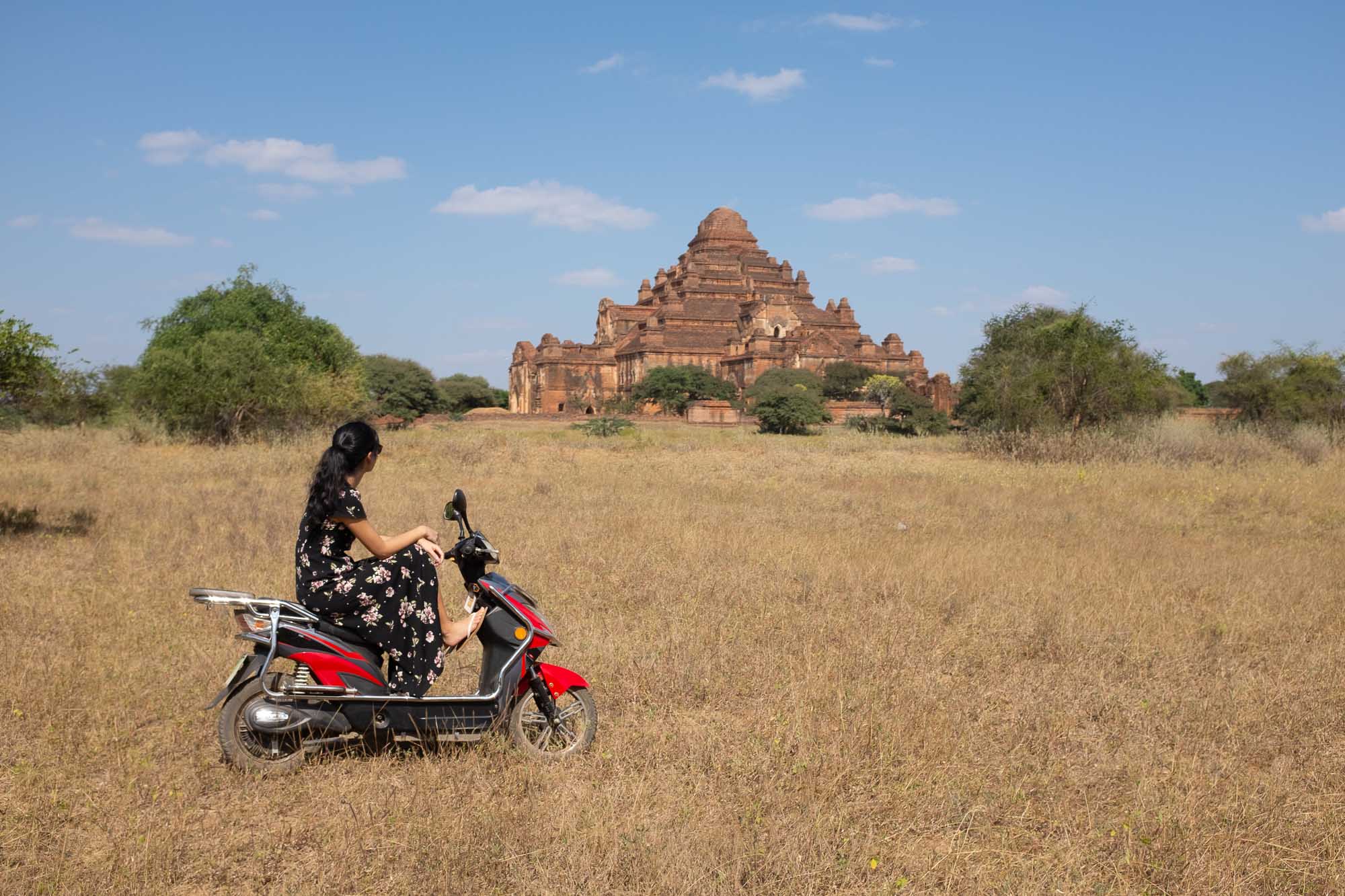
After a while the temples started to blur together so we decided it was a great time to break for lunch. We stopped at The Moon restaurant for a late lunch which serves a complete vegetarian menu. The food was great and provided a much needed break from the scorching sun. In the evening we rode to one of three temples (brick monastery) to see the sunset. It was a great location with views of Utrecht Pagoda, Dhammayazaka Pagoda, Dhammayangyi Temple and in the distance Shwesandaw Pagoda.
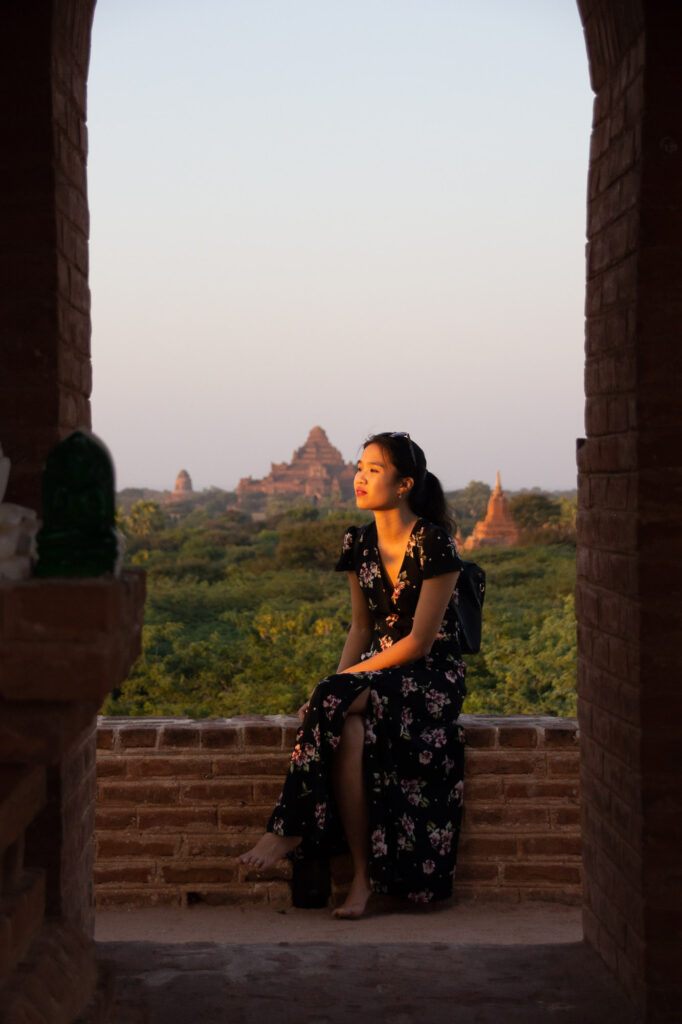
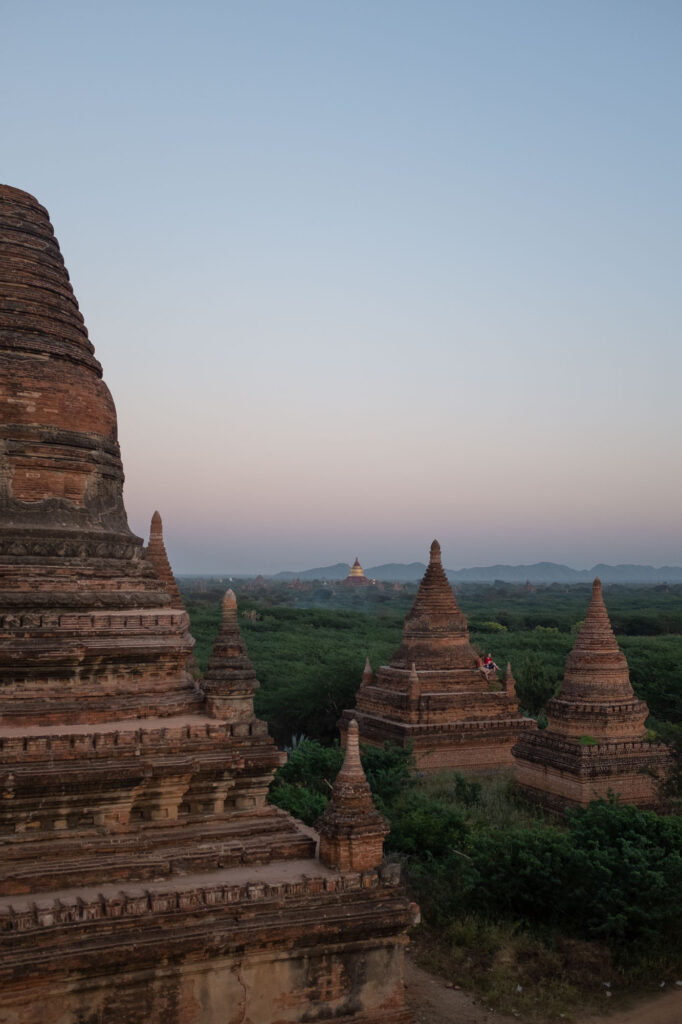
DAY 4: BAGAN
On our last day in Bagan we woke up at 4:30 AM to find a place to watch the sunrise over the temples, this time from the ground. We went back to this temple as it had a cemented roof and a pretty open view. We were the first ones there, and it was still completely dark. Although it was chilly, the next group of people didn’t arrive for another hour, we were glad we got there early because the place filled up really fast and there was no room for people to sit. As the light broke through the horizon, we could see the fog clearing off the ground. Soon after the balloons started to rise up, dancing slowly over the temples. It was a very well coordinated show, and it was certainly worth sacrificing sleep over.
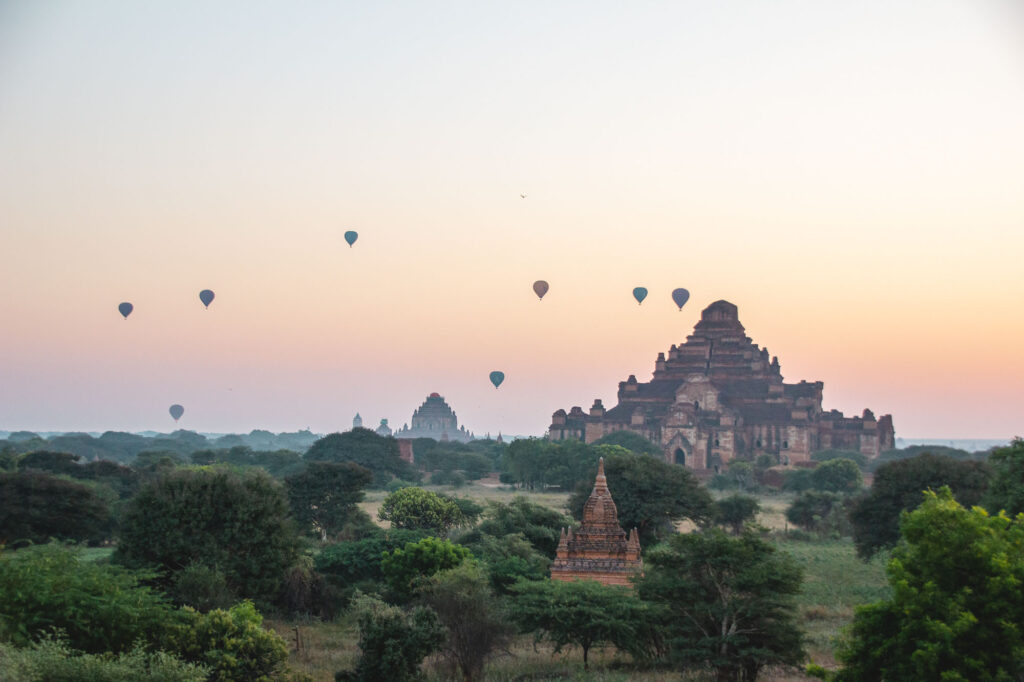
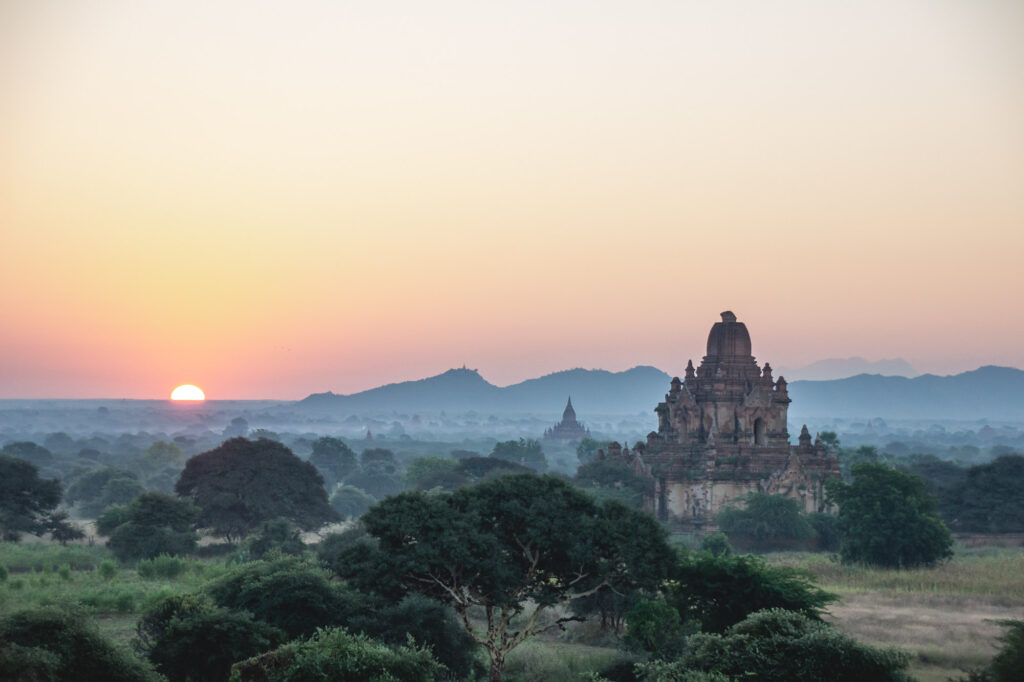
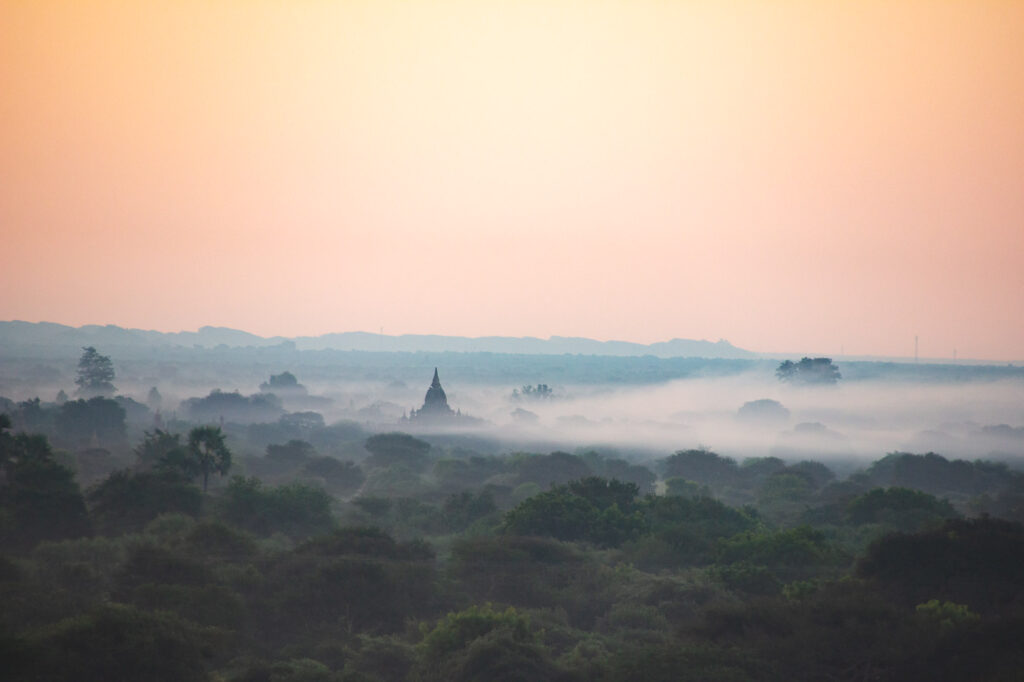
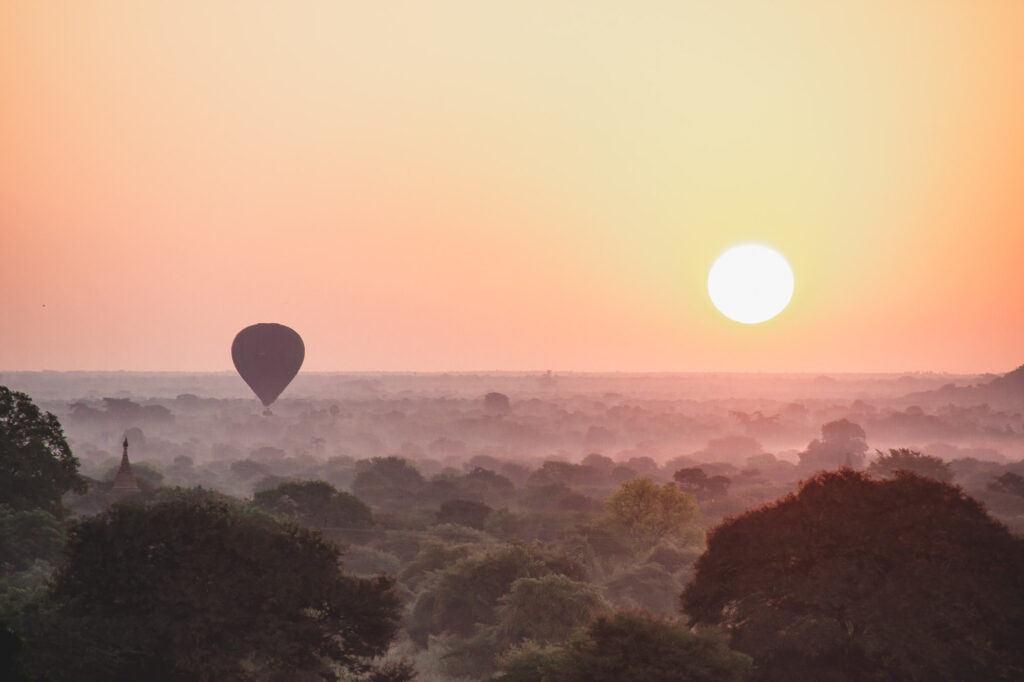
After the balloons landed back on the ground, we took our last pictures and headed back to the hotel, it was time to leave Bagan. While this was the most time we spent in one city in Myanmar we were so happy that we got to take in the temples from both the sky and the ground and catch two beautiful sunrises and sunsets. We would not have done anything differently.
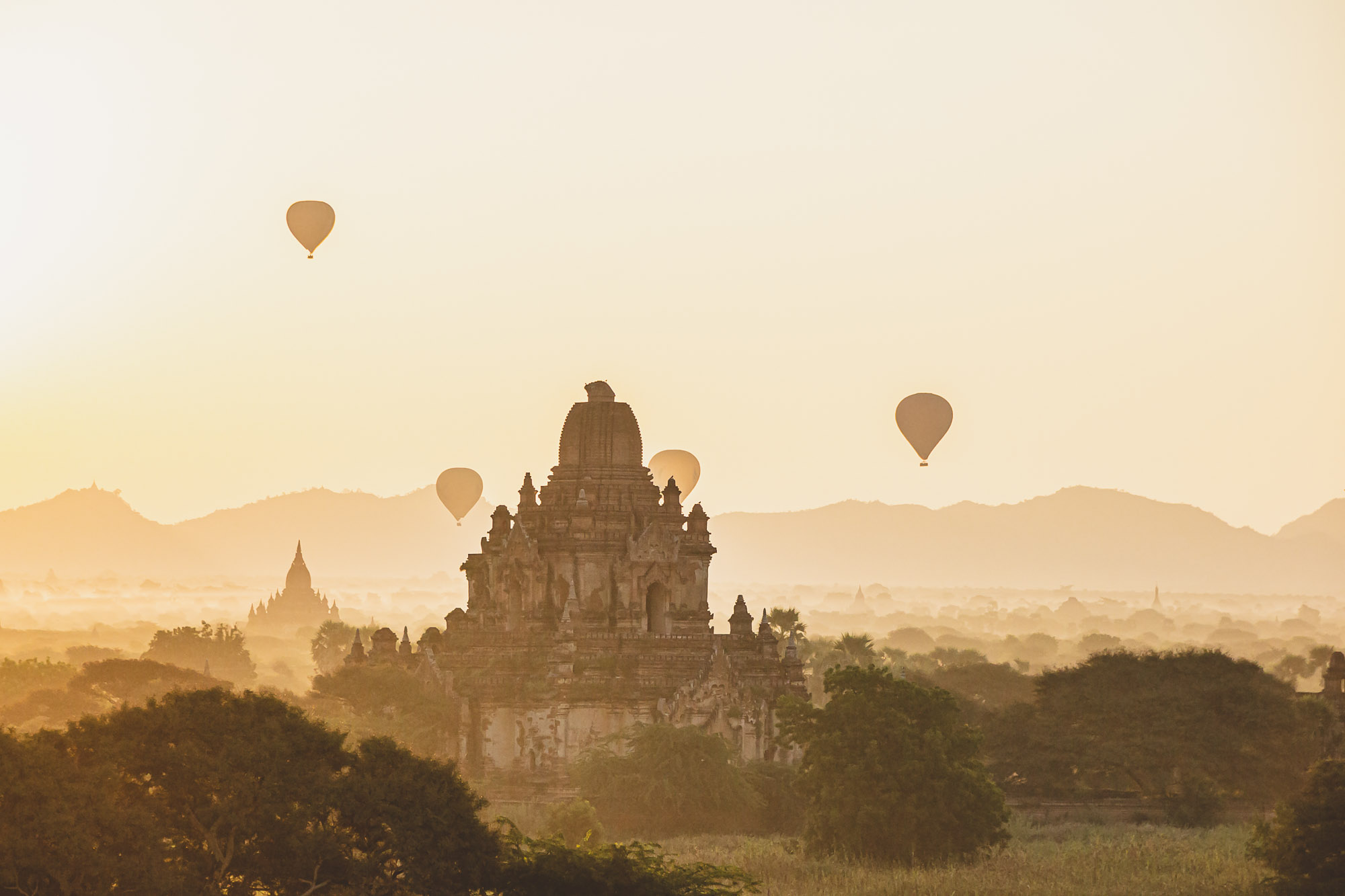
Inle Lake is the second largest lake in Myanmar, located in the Shan highlands. This calm freshwater lake is a rich community of Intha fishermen who live in wooden stilt houses on and around the lake.
DAY 4: INLE LAKE
We had first learned about Inle Lake from one of our coworkers who traveled to Myanmar . His photos of the lake were so unbelievably beautiful that from the first picture we knew we had to work Inle Lake into our itinerary. This meant shortening our time in Mandalay and although we were hesitant at first, after our stay on the lake we knew we had made the right decision for us.
We flew into Heho airport from Bagan, which is the closest airport to the lake. Surprisingly, Shan State has their own immigration within Myanmar. From there we negotiated a taxi to our lake resort, which took us about an hour to get to.
When we arrived at Inle Resort & Spa, we knew right away that this is exactly what we were hoping for – a calming and serene atmosphere with beautiful views. The resort is fairly secluded, with lake side bungalows and sun-soaked terraces. To reach our bungalow, we had to cross a wooden bridge that passed through a beautifully landscaped lotus garden. We relaxed that evening and watched the sun set over the lake from the comfort of our own patio.
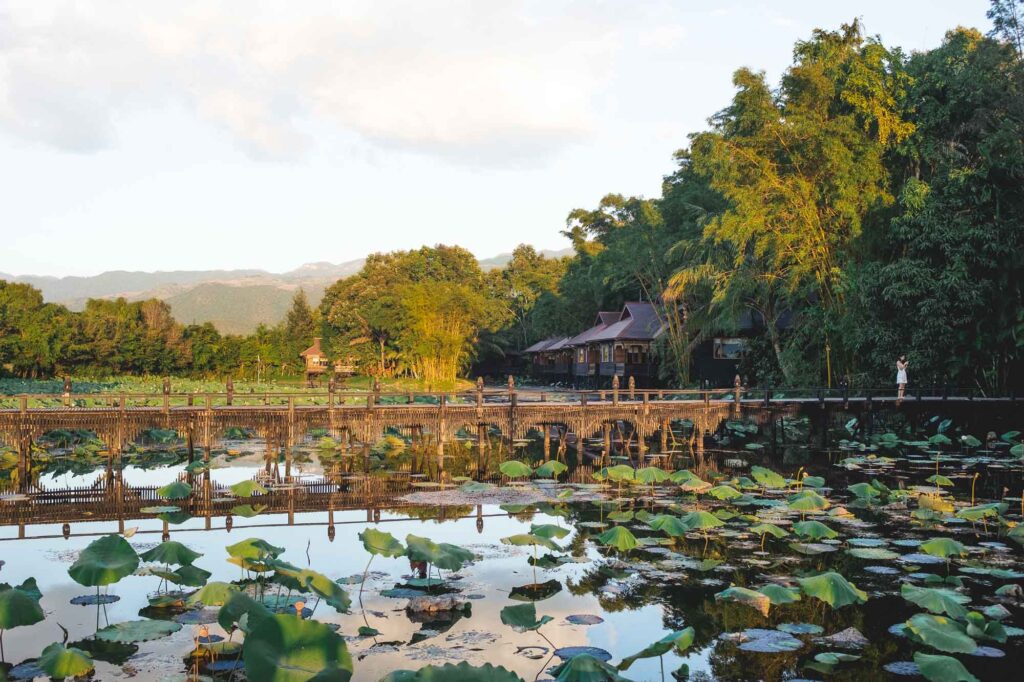
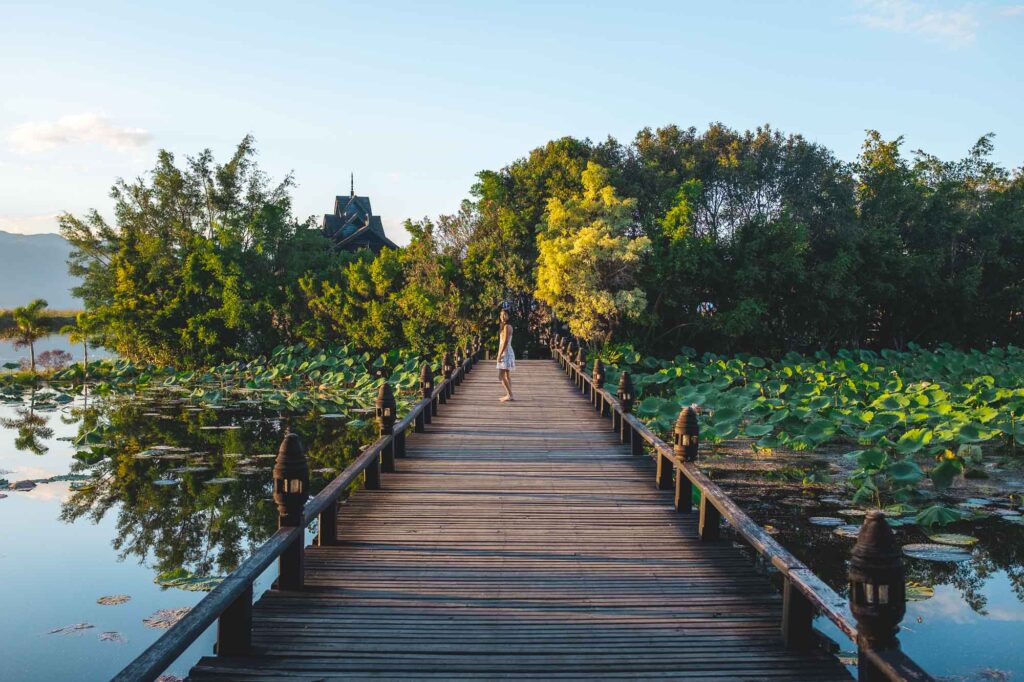
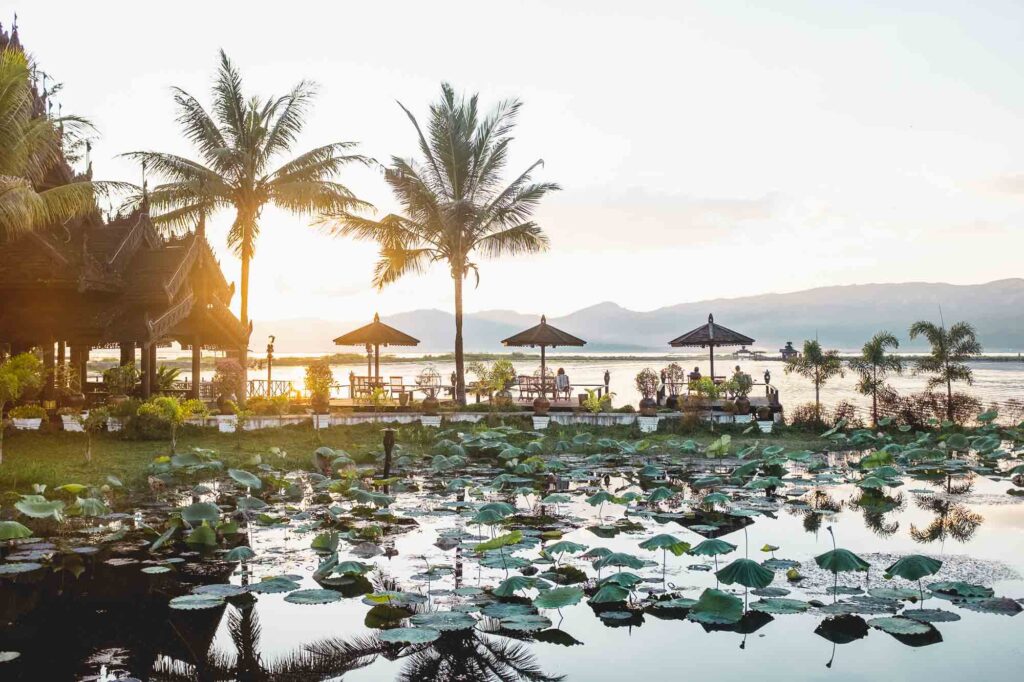
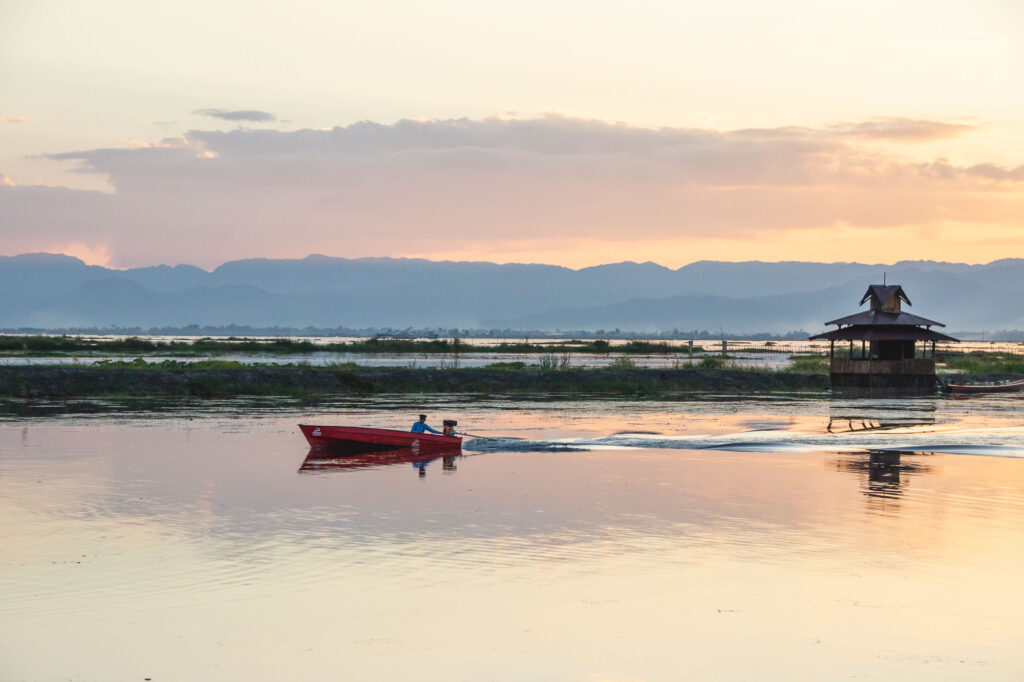
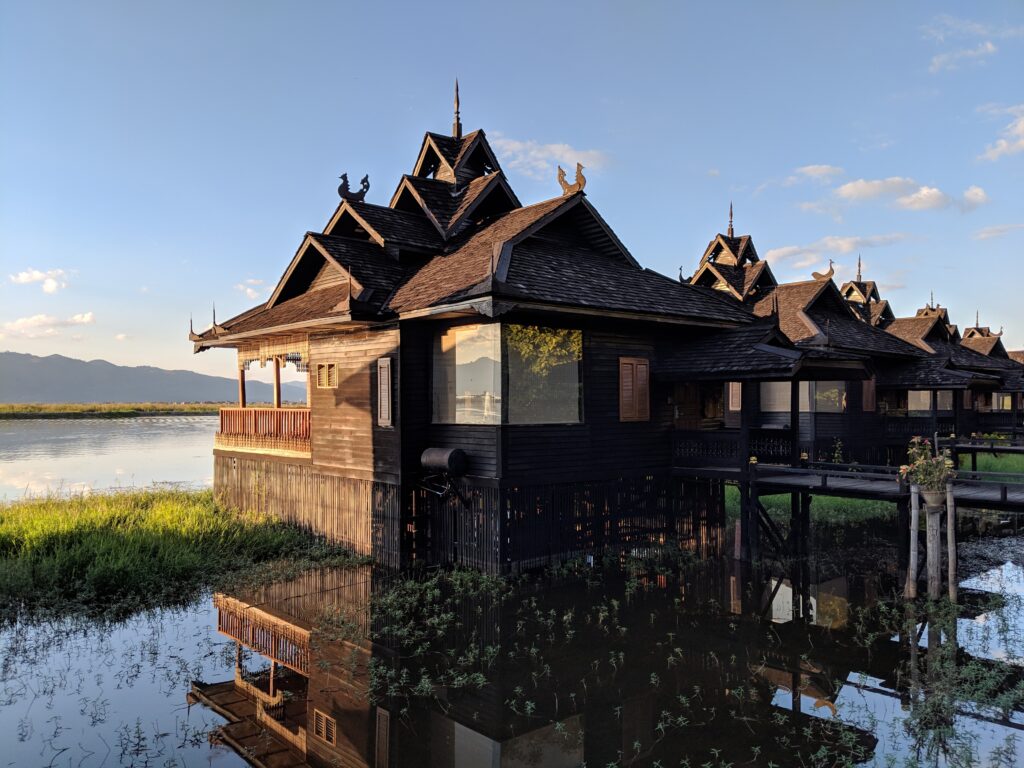
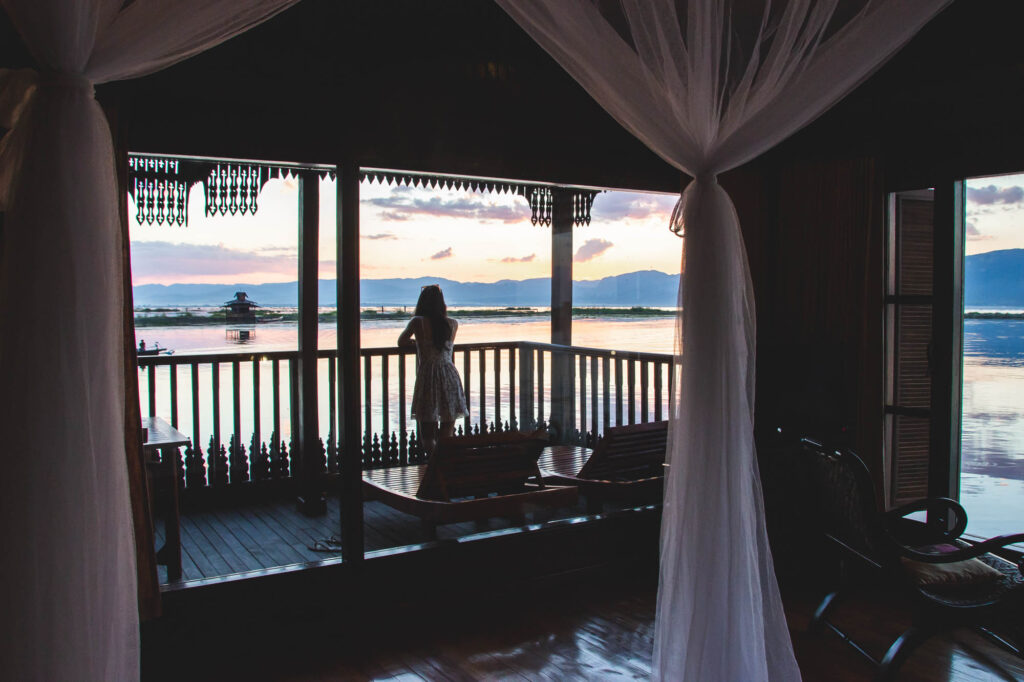
The Inle Lake region has several points of interest which people typically tour by boat. Since this is a popular way to see the region, the hotel had a few tour packages that they could arrange for us. We opted for a full day boat trip that would stop at all of the main highlights.
DAY 5: INLE LAKE
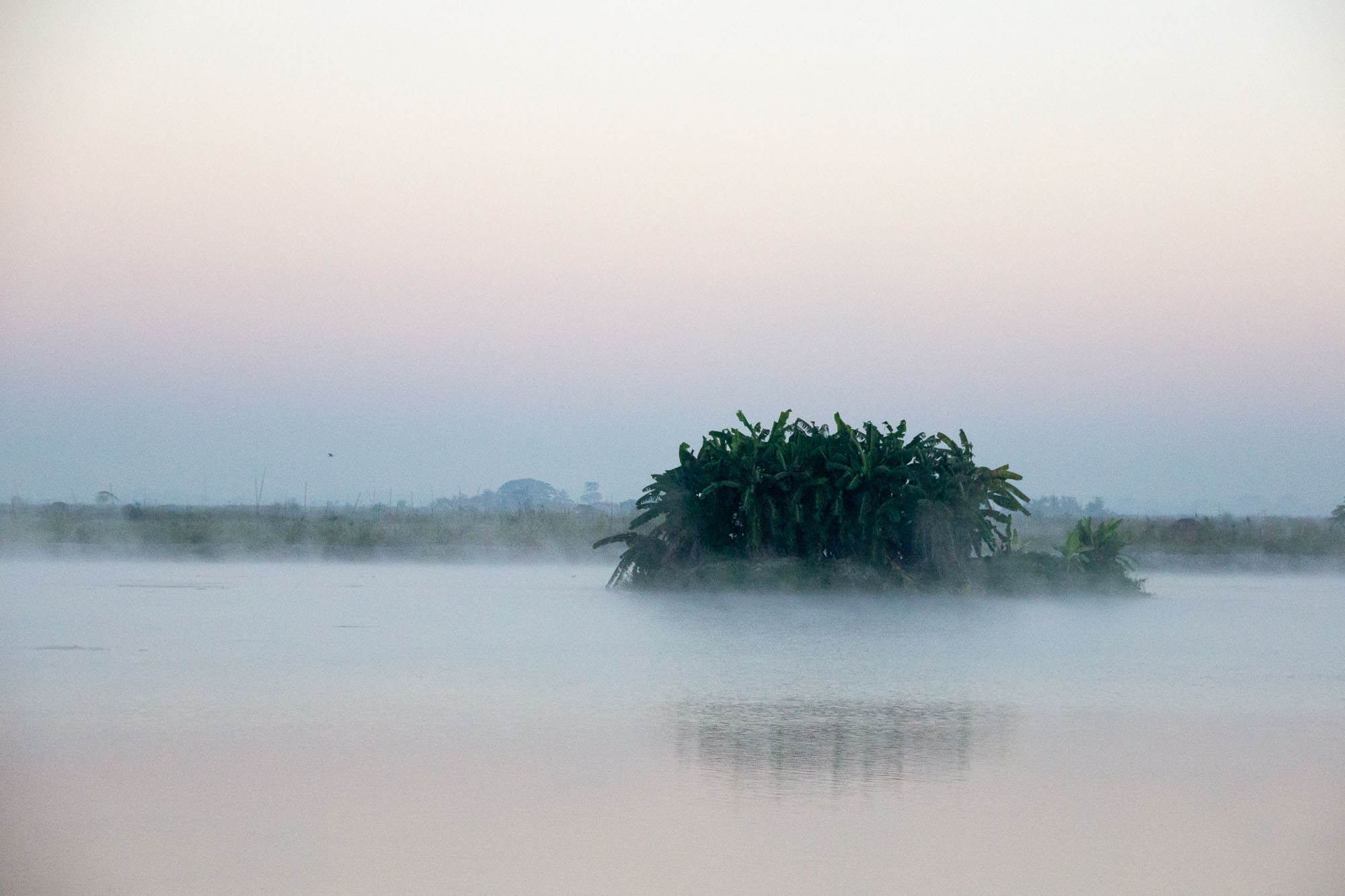
The next morning we met our boat operator at the hotel dock around 6:30 AM. It was a chilly morning and we could see the fog rising up from the lake. He provided us with blankets, which we were very thankful for since it felt much colder than the ~55°F/ 13°C morning temperature due to the boat’s quick speed and constant stream of wind blowing in our faces.
As we left the hotel lagoon for the main lake, we realized how big the lake really was. The only people on the lake this early were Intha fishermen, who demonstrated their unique way of rowing by wrapping their legs around the paddle. We also saw a couple “tourist” fishermen who were dressed in traditional burmese clothes and had a giant conical net. It didn’t seem like they were really catching any fish but regardless they blew us away with their impressive balancing skills.
In the distance we could see the Shan hills as the fog continued to lift up. Soon we were sailing between the floating gardens on the lake. The tomatoes and cucumber plants were floating atop the lake, held in place with the help of bamboo stilts. The gardens were part of an entire floating village of houses – an entire community built on the lake. It was fascinating to us, we hadn’t seen anything like this before.
Our first stop on the lake was at the silversmith workshop where they showed us their process of making extremely intricate designs. In addition to seeing their process you could buy jewellery, souvenirs, and other household items.
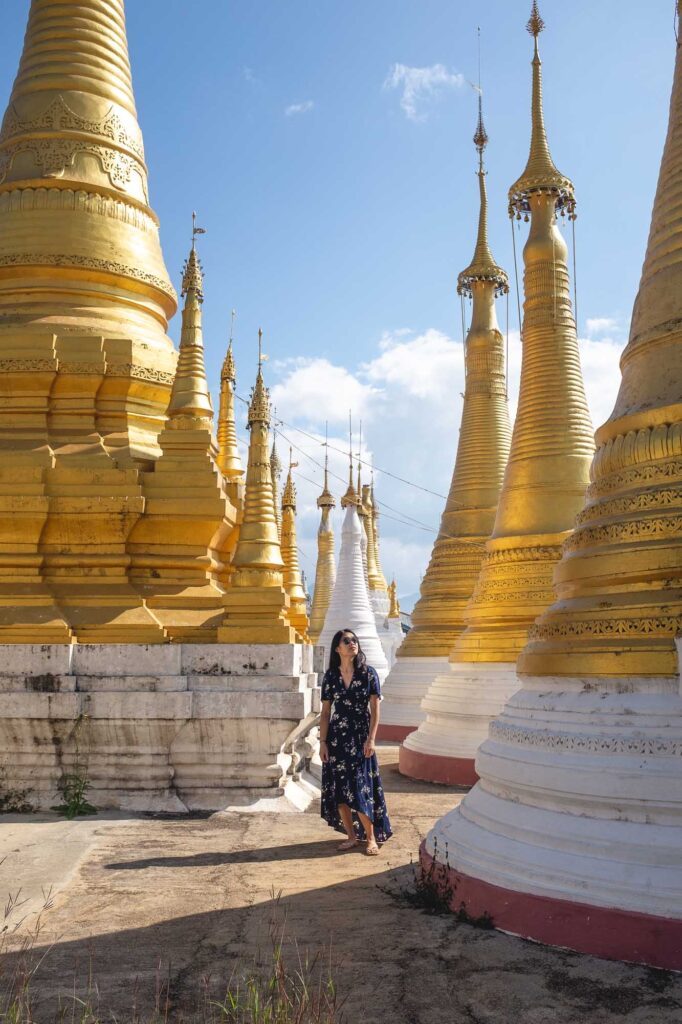
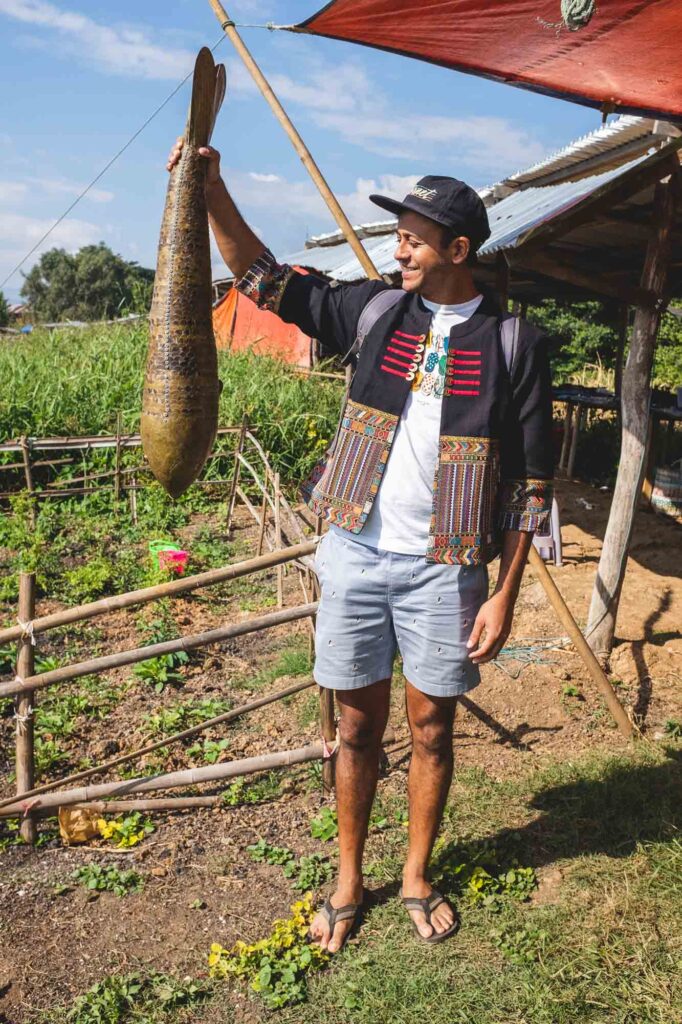
Our next stop was at the 5-day rotating market in Taunggyi. This local market serves the most common shopping needs and rotates through five different sites around the lake area (Nyaungshwe, Heho, Taunggyi, Minethauk, Shwenyaung). At the market we bought ourselves some old burmese currency, an ornate jacket and a small hintha figurine (mythological bird). Right next to the market is the beautiful Aung Mingalar Pagoda, a mix of white and golden stupas.
Climbing back into the boat, we made a few more stops to see how local boats and cheroot cigars are made . It seemed like the boat operators followed a similar path, as both these places were swarming with tourists.
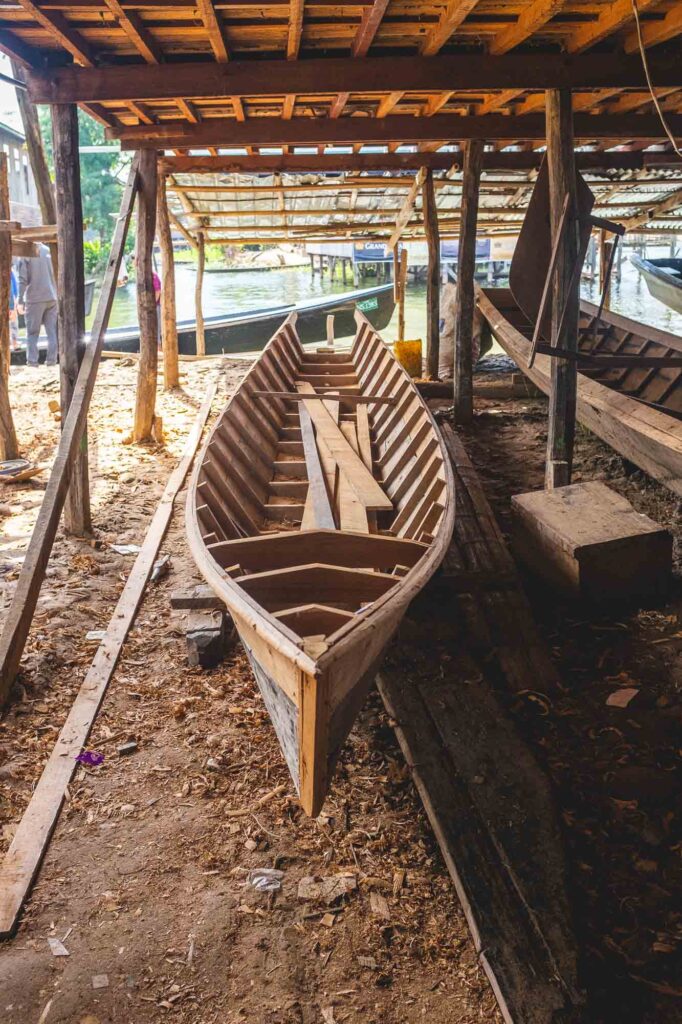
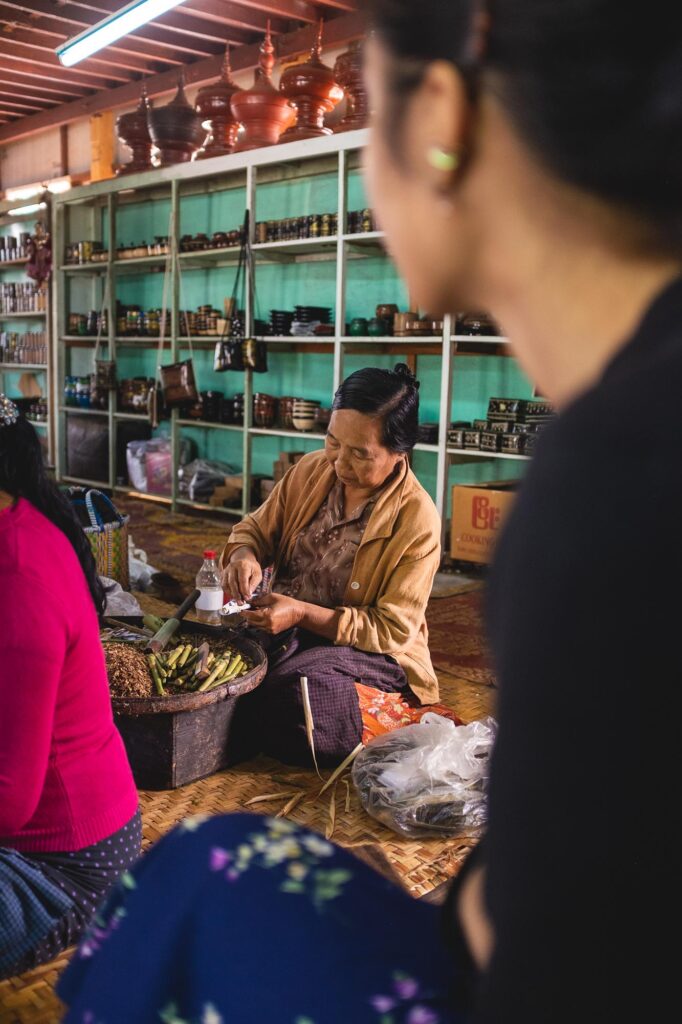
We decided to get lunch at Inle heritage, which is a non-profit organization focused on sustainable accommodations to preserve the nature and culture of the lake. In addition to providing schooling, the organization teaches local people culinary, hospitality, and other vocations.. As we walked the property it was great to see the chefs in training enjoying their craft. The fish we ordered at the restaurant was easily our favorite meal of the entire trip. After lunch we even got to tour the sanctuary for burmese cats. This was not at all like the Jumping cat monasteries, here the cats were just lazing in the sun and enjoying their little cat houses.
Back on the lake we got a chance to see the less touristy side of things. We briefly stopped to look at the famous Phaung Daw Oo Pagoda, which houses five small gilded images of Buddha covered in gold leaf. During the pagoda festival four images are placed on a royal barge designed as a hintha bird and toured between the different villages on the lake.
Our last stop on the tour was the Shwe Indein Pagoda, which was much farther inland and took us a while to get to through the meandering canals. From the spot where the boat dropped us off, it took about 30 minute to reach the Pagodas. The path was very easy to walk, slightly uphill and steps in some places and entirely lined with vendors and souvenirs shops, which provides yet another opportunity to buy local goods. Once at the top, we were greeted with thousands of stupas, made from different materials and in varying stages of preservation. It was amazing to see so many of them in all directions, towering above us gracefully. The forest of stupas was extremely picturesque and we spent quite a while wandering the aisles looking for new stupas to admire.
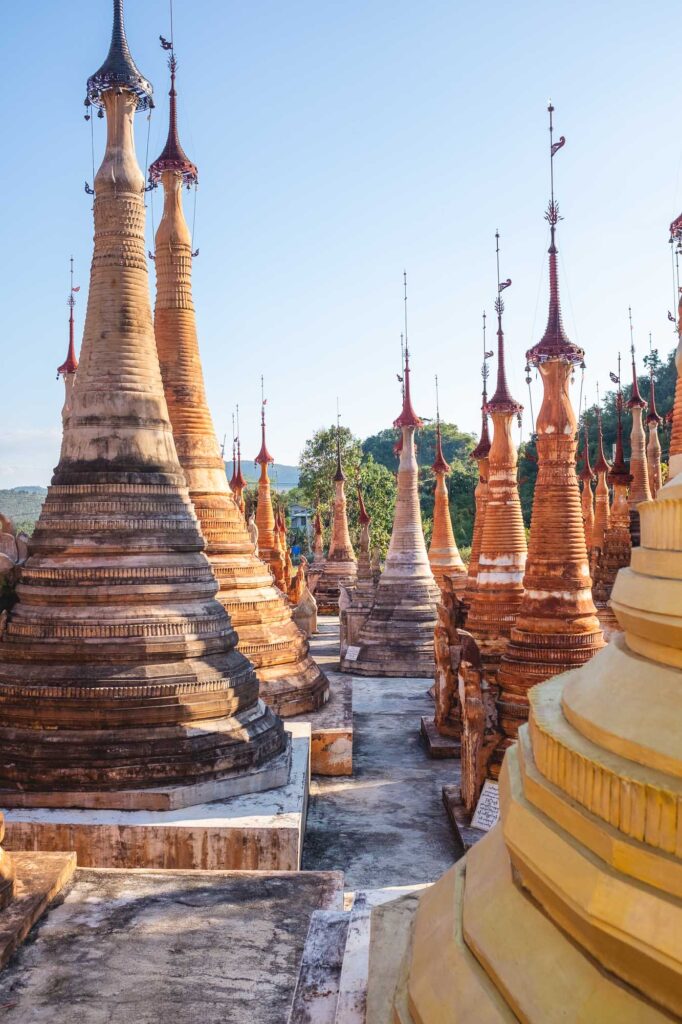
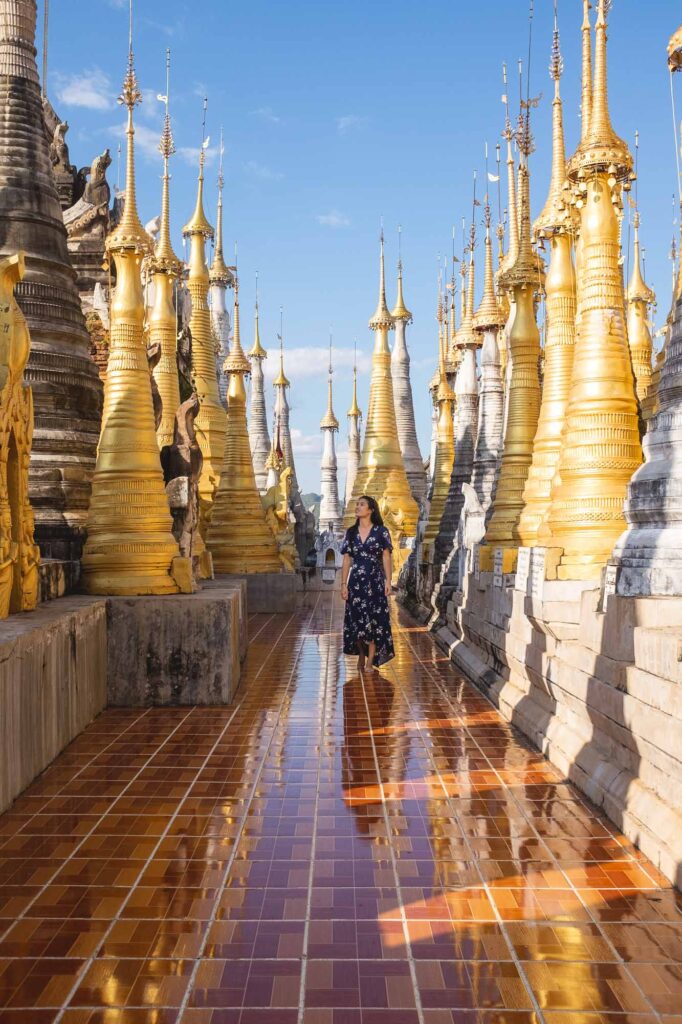
There were several other stops on the tour (jumping cat monastery, lotus weaving) but our energy had started to fade so we decided to head back to the resort. On the way back we got to see more balancing acts of the “tourist” fishermen, who had lined themselves strategically where the tourist boats would pass.
As we sailed back to our hotel we were greeted with a beautiful sunset, this time from the lake. We got to see the sky slowly change colors and see the last of the sun’s rays reflect off the water. Back at the resort we spent the rest of the evening lazing on the sundeck with drinks in our hand until it got dark. It was a long day. In hindsight, we could have skipped a few stops, but we were just happy we had hit all the stops we had wanted to see.
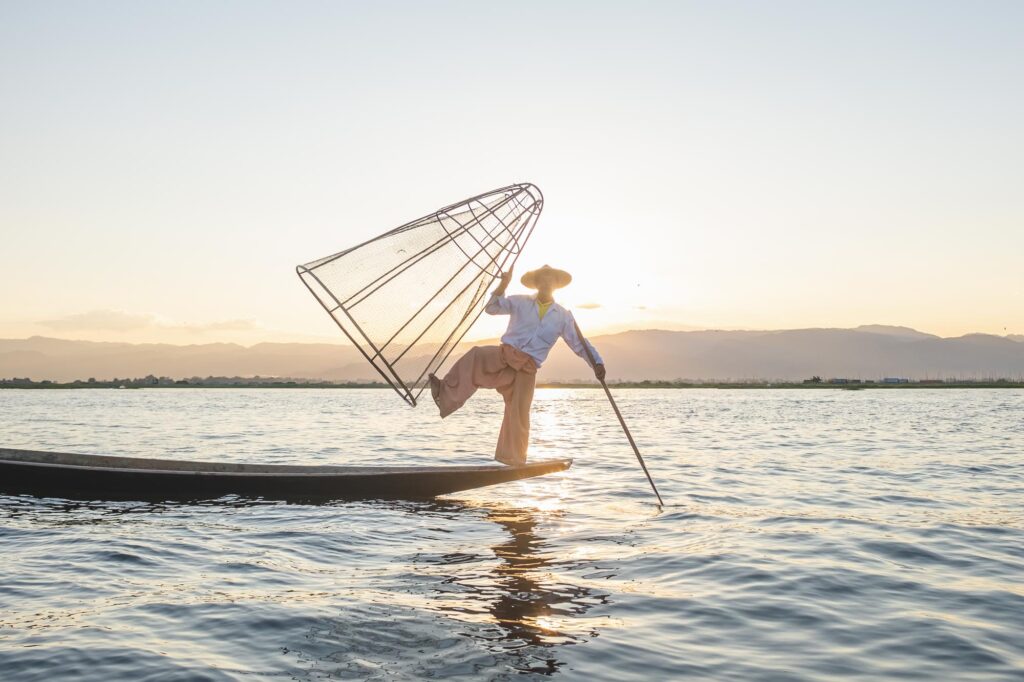
Yangon is the largest and most populated city of Myanmar. It was once the nation’s capital and is still the commercial hub of the country. The city is also home to the country’s most sacred Buddhist temple – Shwedagon Pagoda.
DAY 6: YANGON
We took an early flight from Heho to Yangon and checked in to Sule Shangri-La located in Yangon downtown. Yangon was nothing like what we had experienced in the past few days. It is a busy city, with lots of cars, mopeds, and pedestrians on the city streets. The city is also undergoing construction rapidly and has a mix of modern, colonial and traditional architectures.
Our first stop was to Bogyoke Aung San Market, a short walk from the hotel. Based in central Yangon, this multi-floored bazaar has everything from burmese handicrafts, jewellery stores, art galleries to clothing stores. It is the perfect place to pick up last minute souvenirs, in our case a fridge magnet to remind us of our stay.
It was nearing lunch time so we used the convenient Grab ride sharing app to travel to Rangoon Tea House. A modern, somewhat hipstery restaurant in a renovated colonial era building, they serve a mix of traditional Burmese and Indian cuisine along with several options for traditional tea. We waited about 15 minutes to get a table but it was definitely worth the wait, the food was delicious, especially the Chilli Chicken.
After lunch we walked to the nearby Sule Pagoda, which sits right in the middle of a large traffic circle. This part of the town is extremely busy and has a nonstop stream of vehicles circling the temple. We used one of the foot bridges to reach the temple entrance. On the inside, it was much quieter, a welcome break from the heat and traffic outside.
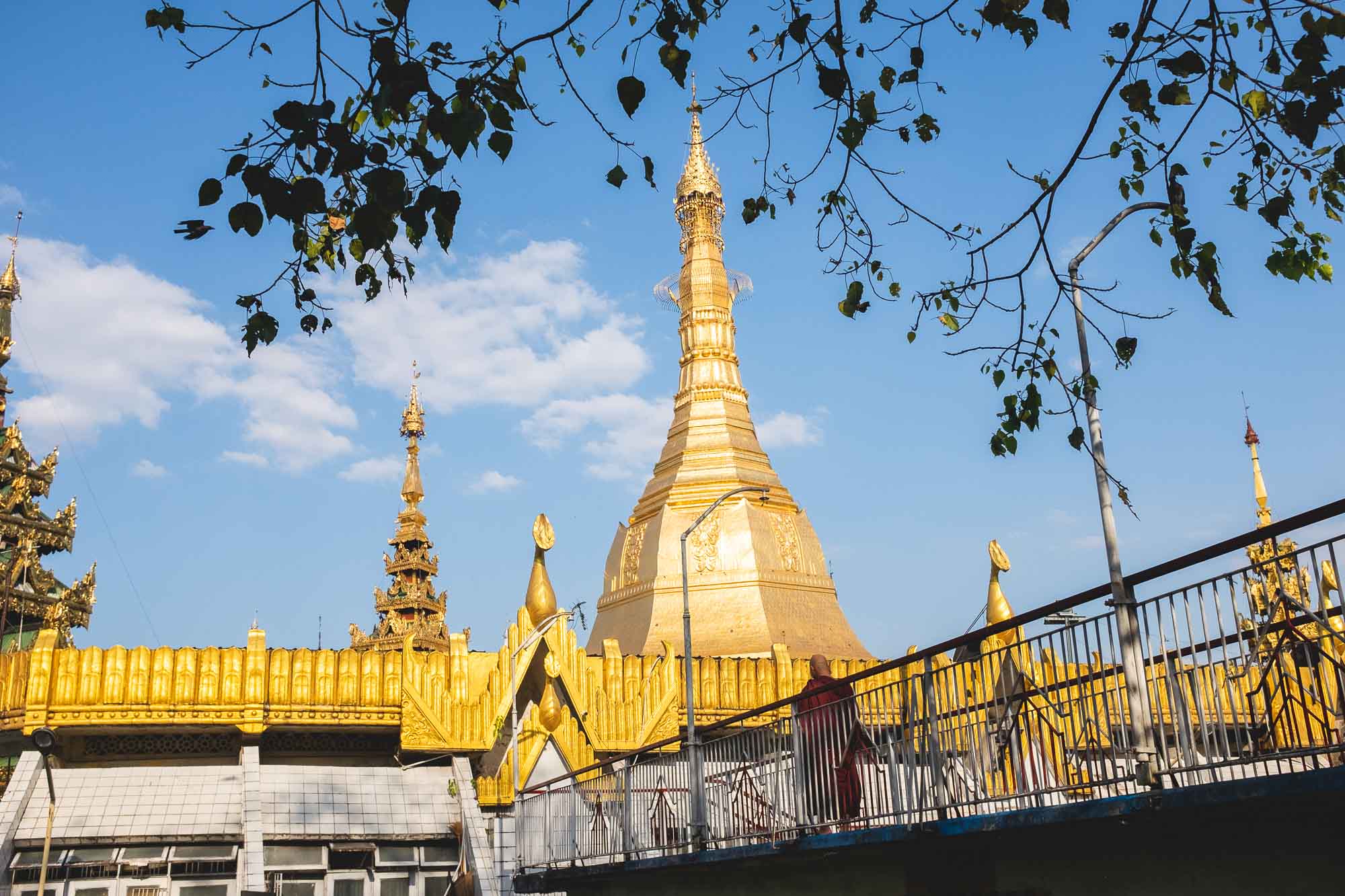
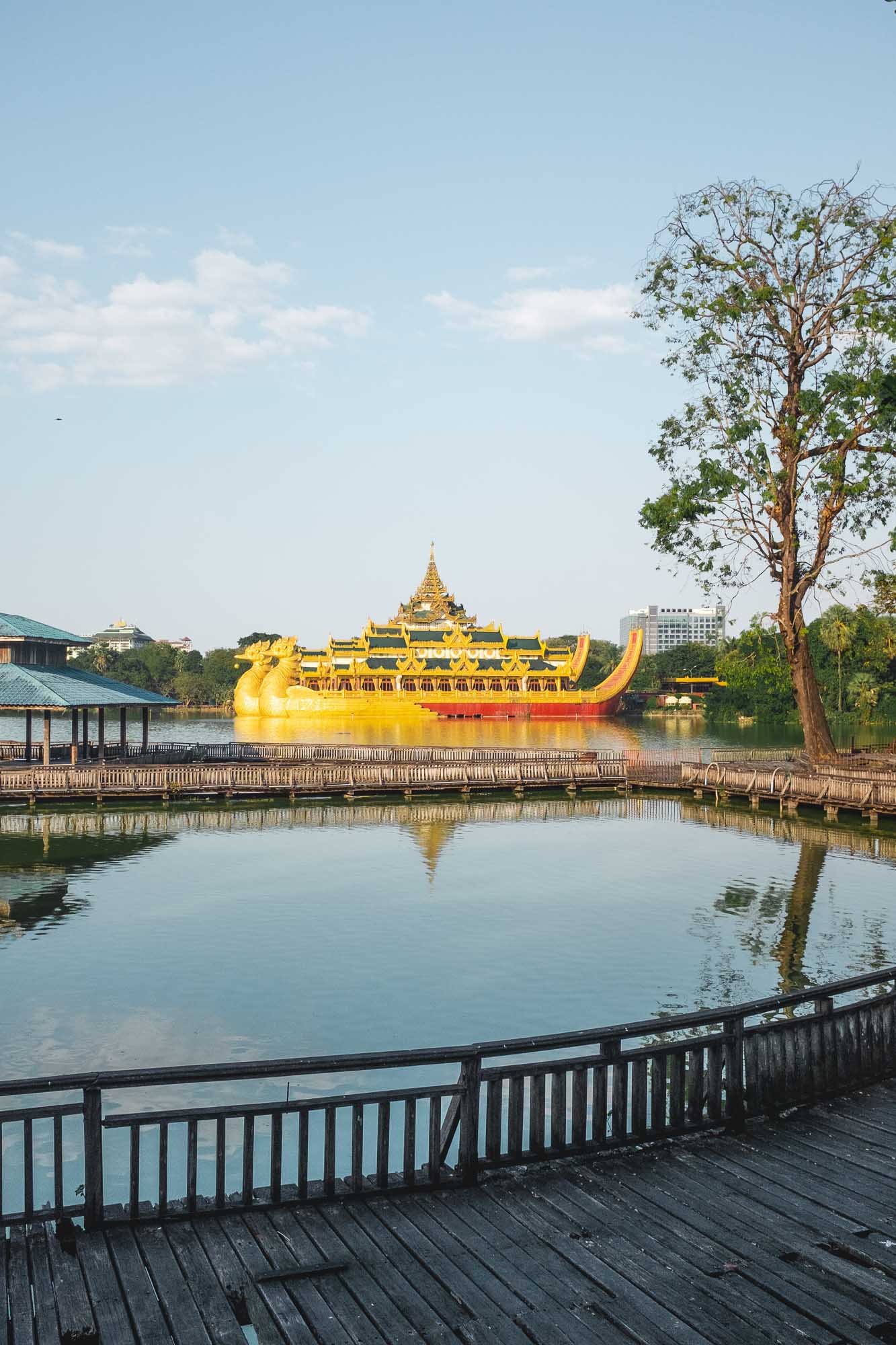
Our next stop was Kandawgyi Lake (meaning “the great lake”) which is an artificial lake surrounded by a nature park and zoological gardens. The main attraction is Karaweik Palace, which is a large replica of a Royal barge built on the eastern side of the lake. The Palace is golden in color with two large birds guarding a magnificent pyramid of green and gold roofs. We paid an entrance fee for the nature park and walked slowly around the southern edge to admire the barge’s reflection in the lake..
Right next to the lake is the famous Shwedagon Pagoda. Walking from the park to the temple took slightly longer than expected, especially considering the heat, but it provided us a great opportunity to see life around the temples. Unlike Sule Pagoda, Shwedagon is massive, when you first enter and remove your shoes you’re still several staircases away from the main area of worship. At the center of the temple is a tall golden stupa surrounded by several smaller stupas, and many Buddha statues can be found across the complex. After spending some time admiring the ornate details of the temple we left through the western stairway to view the temple from afar. What we didn’t realize was that we could have walked to the northern entrance to see the full length of the temple without being too close to it.
Across from western entrance is the People’s Square and Park. Although we had to pay an entrance fee we were greeted with great views of the temple and spent the rest of the evening lying on the lawn waiting for twilight to come and the temple lights to turn on (which sadly also meant mosquitos).
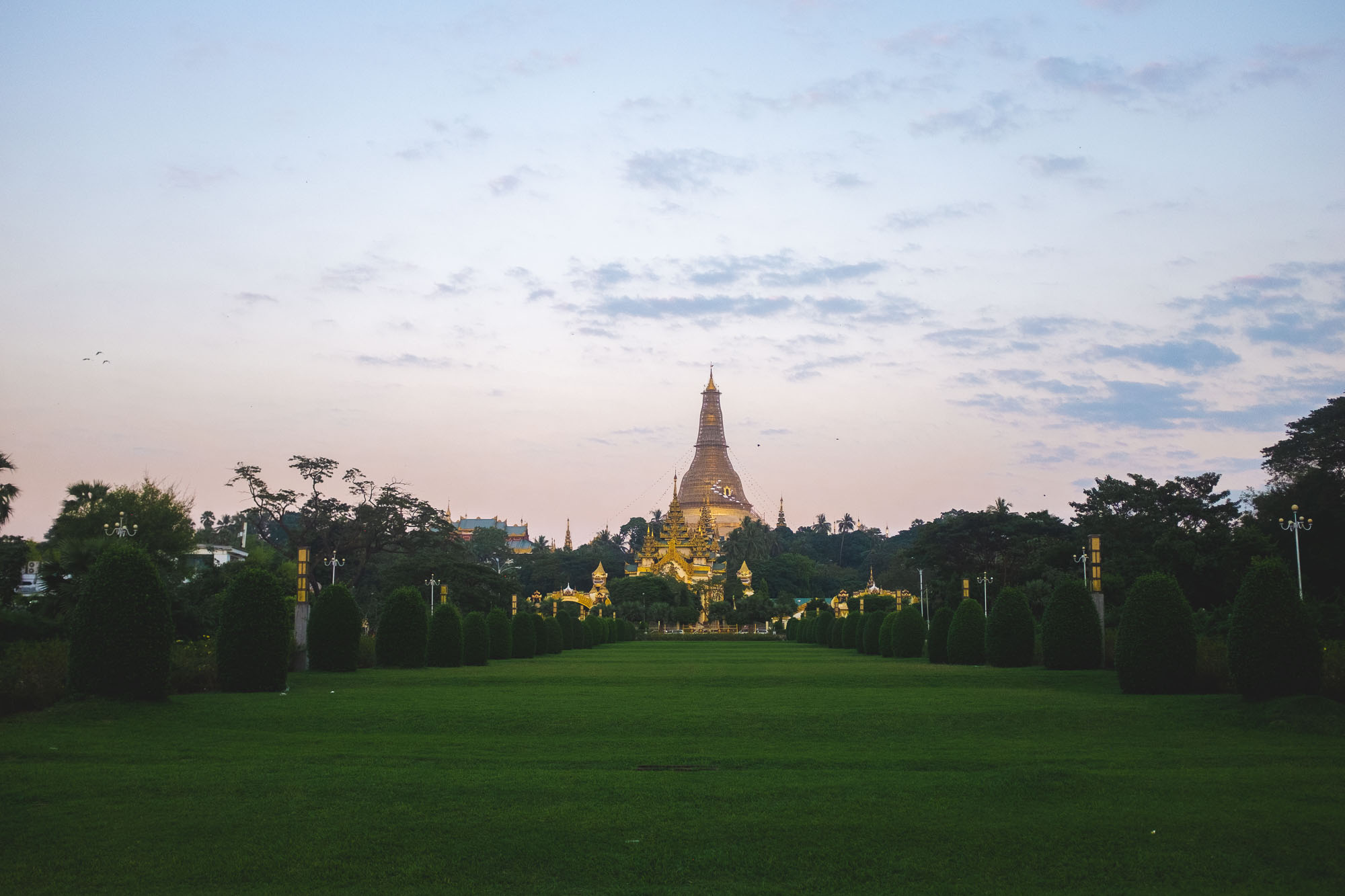
For our last dinner in Myanmar we set our sights on Chinatown. We took a cab to the bustling area with many street side markets and eateries. We browsed around looking at the offerings of the grilled skewer stations and fruit vendors before finally settling on a 999 Shan Noodle Shop which is away from the main street. It is a small restaurant filled with locals and serves delicious noodle dishes.
Heading back from dinner we crossed a footbridge over Sule Pagoda road, which provided a beautiful view of the temple, now glowing in the darkness and surrounded by the lights of traffic. To round out our last evening in Yangon, we made one more stop at Yangon Yangon, a rooftop bar in Sakura tower which was right across from our hotel. The bar has sweeping views of the city and is a perfect place for a nightcap. We got to sip our last cocktails in Myanmar while watching the golden light of Shwedagon Pagoda shining bright over the rest of the city.
Our trip to Myanmar was certainly one of the best trips we’ve taken. With its long historical past, rich cultural heritage and panoramic landscapes, Myanmar is guaranteed to make a lasting impression. <3
